

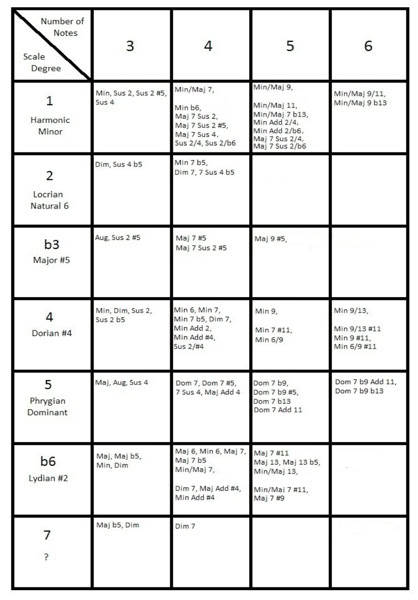
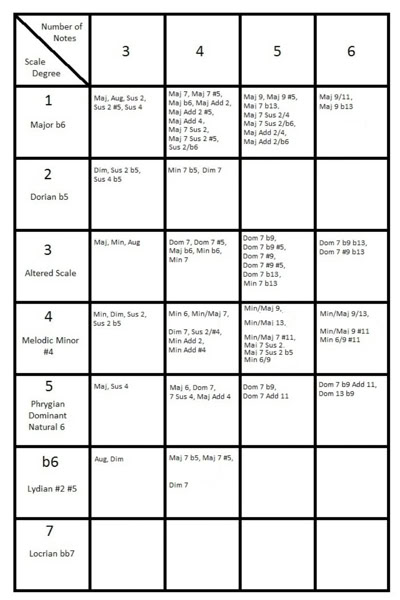
An Exploration Of Musical Shapes
Introduction
This is a reference work on guitar, which focuses on what possible shapes there are to play, and how they fit in families. I know that there is more to music than what chord goes in what scale, but it is nonetheless applicable information. There are a limited amount of possible combinations of notes in 12-tone music. There are quite a lot of ways to combine them if you do have chromatic parts in the shape. If we do not ever have 3 notes in a row, that is, 2 consecutive half steps, things get clearer. A framework emerges. If we say that as a general rule there is always a 5th, be it natural flat or sharp, and never 3 notes, 2 consecutive half steps in a row, there can be rendered a limited number of very useful shapes, that can be learned. In this book I have detailed every possible combination of notes using those rules, with a few exceptions that didn't seem to fit, or necessary to document.
One thing that will be apparent is that I featured fewer chords than I did arpeggios. This is because some chords are physically difficult or impossible to fret. However, in the Formula Lists section,I have shown 106 chord/arpeggio formulas, where I have listed chords by number of notes in the chord, and their formulas. I have also shown how they invert into one another, when they do. For example, you may know that a Min 7 inverts into a Maj 6 – this principle applies to many chord types. The Chord/Scale Tables show modes as I have named them with chords that go in each mode, again by number of notes in each chord. In this way a person can readily identify what chords may fit in what positions, and perhaps knowing inversions, can employ a lot of ideas on one spot or anywhere on the fretboard.
There are also two types of arpeggios I have shown, caged arpeggios and diagonally ascending arpeggios. I have consolidated all formulas into one octave at a time. For example an arpeggio with a formula containing a 9 will be shown as a 2 instead. There's a ton of great riff material there. Some of the arpeggios are not as shreddable or sweepable as others, they are nonetheless each a unique sound or taste. In order to augment these arpeggio diagrams, I have included a diagram of arpeggios that exceed an octave with stacked intervals.
There are other interesting sections, you can explore for yourself. This work began as a self study for my own learning, but I realized it could be of worth to others, so, I've spent the last few years writing and rewriting the most encyclopedic summation I could of shapes and how they fit among one another.
The main approach is using whole fretboards. That's how I try to play, to map the entire fretboard with shapes or scales. By learning positions, and learning to switch between them smoothly, one can learn to see the whole fretboard with a scale or arpeggio on it.
There are 7 scales in music that do not contain two consecutive half steps and have no notes taken out, each with modes. Some modes are more applicable than others. I have tried to outline the easiest to use modes. Of course the Chromatic Scale and use of chromatics or removing notes is perfectly fine. So, with this information contained in this work, I hope that whatever the genre, it will be applicable somehow. It's rather generic, just raw data basically.
This work does not teach composition, or chord substitution and so on. Again, it's generic information for any genre. In the right context a chord that sounds like mud rings.
There are plenty of fretboards full of formula if you would like to make up new ways to play chords. Also, there are different ways to choose strings to play chords on. I have shown a fair amount.
I hope you find this book helpful somehow in your journey with guitar. I'm glad to share what I know, and want to study it now that it's done.
Much love! ~ Walter
Chord/Scale Tables




Formulas Lists
Pentatonic Minor: 1,b3,4,5,b7
Pentatonic Major: 1,2,3,5,6
Pentatonic Neutral: 1,2,4,5,b7
Pentatonic Daffy: 1,2,4,5,6
Major: 1,2,3,4,5,6,7
Dorian: 1,2,b3,4,5,6,b7
Phrygian: 1,b2,b3,4,5,b6,b7
Lydian: 1,2,3,#4,5,6,7
Mixolydian: 1,2,3,4,5,6,b7
Minor: 1,2,b3,4,5,b6,b7
Locrian: 1,b2,b3,4,b5,b6,b7
Melodic Minor: 1,2,b3,4,5,6,7
Phrygian Natural 6: 1,b2,b3,4,5,6,b7
Lydian #5: 1,2,3,#4,#5,6,7
Lydian Dominant: 1,2,3,#4,5,6,b7
Melodic Dominant: 1,2,3,4,5,b6,b7
Locrian Natural 2: 1,2,b3,4,b5,b6,b7
Whole Tone Altered: 1,b2,#2,3,#4,#5,b7
Harmonic Minor: 1,2,b3,4,5,b6,7
Locrian Natural 6: 1,b2,b3,4,b5,6,b7
Major #5: 1,2,3,4,#5,6,7
Dorian #4: 1,2,b3,#4,5,6,b7
Phrygian Dominant: 1,b2,3,4,5,b6,b7
Lydian #2: 1,#2,3,#4,5,6,7
?: 1,b2,#2,3,#4,#5,6-bb7
Major b6: 1,2,3,4,5,b6,7
Dorian b5: 1,2,b3,4,b5,6,b7
Altered Scale: 1,b2,#2,3,5,b6,b7
Melodic Minor #4: 1,2,b3,#4,5,6,7
Phrygian Dominant Natural 6: 1,b2,3,4,5,6,b7
Lydian #2 #5: 1,#2,3,#4,#5,6,7
Locrian bb7: 1,b2,b3,4,b5,b6,6-bb7
Whole Tone: 1,2,3,#4,#5,b7
Augmented: 1,#2,3,5,b6,7
Diminished: 1,2,b3,4,b5,b6,6,7
Diminished 2nd Mode: 1,b2,#2,#4,5,6,b7
Double Harmonic Minor: 1,2,b3,#4,5,b6,7
Double Harmonic 5th Mode: 1,b2,3,4,5,b6,7
Whole Tone Offset: 1,b2,b3,4,5,6,7
Three Note Chords
Maj - 1,3,5
Maj b5 - 1,3,b5
Min - 1,b3,5
Aug - 1,3,#5
Dim - 1,b3, b5
Sus 2 - 1,2,5
Sus 4 - 1,4,5
Sus 2 b5 - 1,2,b5
Sus 2 #5 - 1,2,#5
Four Note Chords
Maj 6 - 1,3,5,6
Maj 7 - 1,3,5,7
Maj 7 b5 - 1,3,b5,7
Maj 7 #5 - 1,3,#5,7
Maj 7 Sus 2 - 1,2,5,7
Maj 7 Sus 4 - 1,4,5,7
Maj Add 2 - 1,2,3,5
Maj Add 2 b5 - 1,2,3,b5
Maj Add 2 #5 - 1,2,3,#5
Maj Add 4 - 1,3,4,5
Maj Add #4 - 1,3,#4,5
Maj b6 - 1,3,5,b6
Dom 7 - 1,3,5,b7
Dom 7 b5 - 1,3,b5,b7
Dom 7 #5 - 1,3,#5,b7
Dom 7 Sus 2 - 1,2,5,b7
Dom 7 Sus 2 b5 - 1,2,b5,b7
Dom 7 Sus 2 #5 - 1,2,#5,b7
Dom 7 Sus 4 - 1,4,5,b7
Dom 7 Sus 4 b5 - 1,4,b5,b7
Min 6 - 1,b3,5,6
Min 7 - 1,b3,5,b7
Min 7 b5 - 1,b3,b5,b7
Min Add 2 - 1,2,b3,5
Min Add 4 - 1,b3,4,5
Min Add #4 - 1,b3,#4,5
Min b6 - 1,b3,5,b6
Min/Maj 7 - 1,b3,5,7
Sus 2/4 - 1,2,4,5
Sus 2/6 - 1,2,5,6
Sus 2/#4 - 1,2,#4,5
Sus 2 b6 - 1,2,5,b6
Dim 7 - 1,b3,b5,6
Five Note Chords
6/7 - 1,3,5,6,b7
6/9 - 1,3,5,6,9
Dom 7 b9 - 1,3,5,b7,b9
Dom 7 b9 b5 - 1,3,b5,b7,b9
Dom 7 b9 #5 - 1, 3, #5 ,b7, b9
Dom 7 #9 - 1,3,5,b7,#9
Dom 7 #9 b5 - 1,3,b5,7,#9
Dom 7 #9 #5 - 1,3,#5,b7,#9
Dom 7 Add 11 - 1,3,5,b7,11
Dom 7 #11 - 1,3,5,b7,#11
Dom 7 #11 #5 - 1,3,#5,b7,#11
Dom 7 b13 - 1,3,5,b7,b13
Maj 9 - 1,3,5,7,9
Maj 9 b5 - 1,3,b5,7,9
Maj 9 #5 - 1,3,#5,7,9
Dom 9 - 1,3,5,b7,9
Dom 9 b5 - 1,3,b5,b7,9
Dom 9 #5 - 1,3,#5,b7,9
Dom 11 - 1,5,b7,9,11
Maj 13 - 1,3,5,7,13
Maj 13 b5 - 1,3,b5,7,13
Min 6/9 - 1,b3,5,6,9
Min 7 #11 - 1,b3,5,b7,#11
Min 7 b13 - 1,b3,5,b7,b13
Min 9 - 1,b3,5,b7,9
Min/Maj 9 - 1,b3,5,7,9
Min 11 - 1,b3,5,b7,11
Min 13 - 1,b3,5,b7,13
Min/Maj 11 - 1,b3,5,7,11
Min/Maj 7 #11 - 1,b3,5,7,#1
Min/Maj 7 b13 - 1,b3,5,7,b13
Min/Maj 13 - 1,b3,5,7,13
Maj Add 2/4 - 1,2,3,4,5
Min Add 2/4 - 1,2,b3,4,5
Maj Add 2/b6 - 1,2,3,5,b6
Min Add 2/b6 - 1,2,b3,5,b6
Maj 7 Add 11 - 1,3,5,7,11
Maj 7 #11 - 1,3,5,7,#11
Maj 7 b13 - 1,3,5,7,b13
Six Note Chords
6/9 #11 - 1,3,5,6,9,#11
9/11 - 1,3,5,b7,9,11
9/13 - 1,3,5,7,9,13
Maj 9/11 - 1,3,5,7,9,11
Maj 9 #11 - 1,3,5,7,9,#1
Maj 9 b13 - 1,3,5,7,9,b13
Dom 9 #11 -1,3,5,b7,9,#11
Dom 9 #11 #5 - 1,3,#5,b7,9,#11
Dom 9 b13 - 1,3,5,b7,9,b13
Dom 13 - 1,3,5,b7,9,13
Dom 13 b5 - 1,3,b5,7,9,13
Dom 13 b9 - 1,3,5,b7,b9,13
Dom 13 #9 - 1,3,5,b7,#9,13
Min 6/9 #11 - 1,b3,5,6,9,#11
Min 9 b13 1,b3,5,b7,9,b13
Min 9/11 - 1,b3,5,b7,9,1
Min 9 #11 - 1,b3,5,b7,9,#11
Min 9/13 - 1,b3,5,b7,9,13
Min/Maj 9/11 - 1,b3,5,7,9,1
Min/Maj 9 #11 - 1,b3,5,7,9,#1
Min/Maj 9/13 - 1,b3,5,7,9,13
Min/Maj 9 b13 - 1,b3,5,7,9,b13
Dom 7 b9 Add 11 - 1,3,5,b7,b9, 11
Dom 7 b9 b13 - 1,3,5,b7,b9,b13
Dom 7 #9 b13 - 1,3,5,b7,#9,b13
Basic Chords
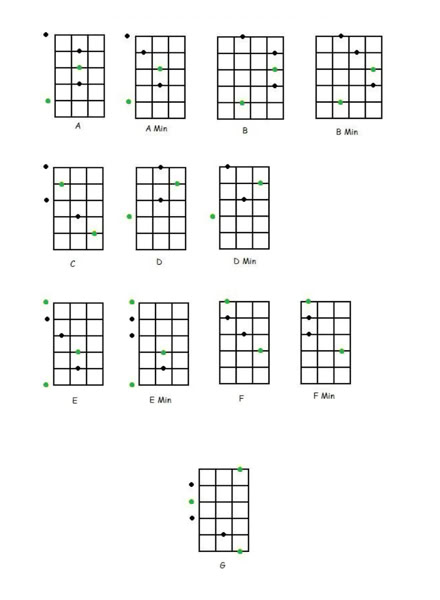


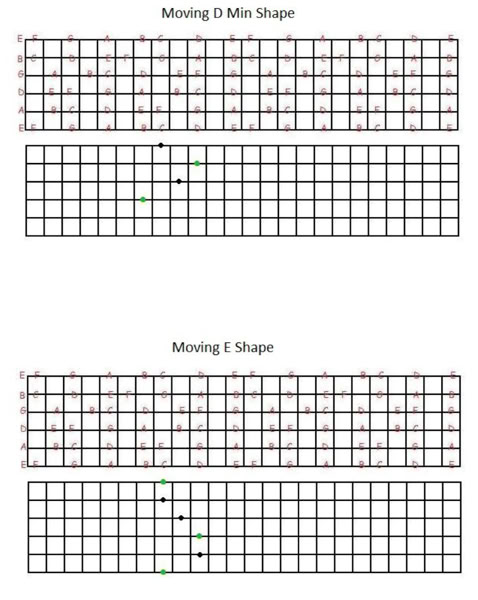


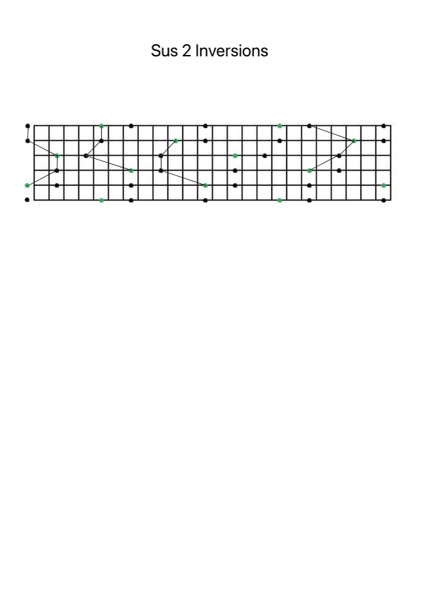

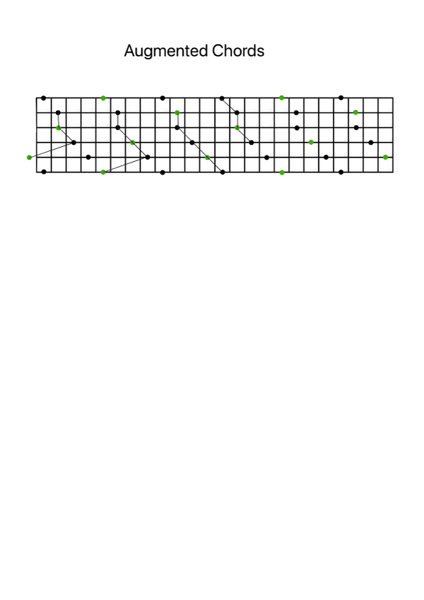
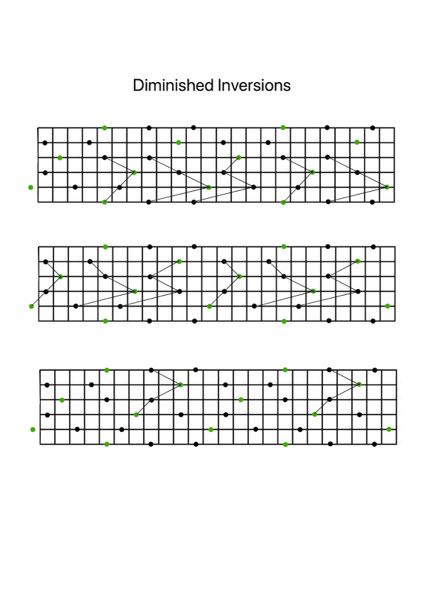
4 Note Chords
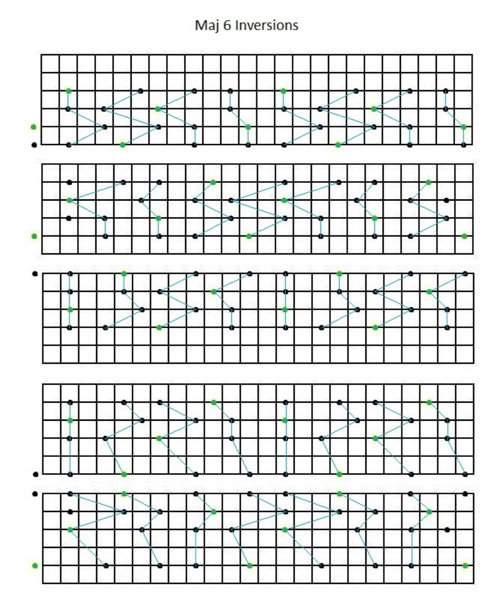
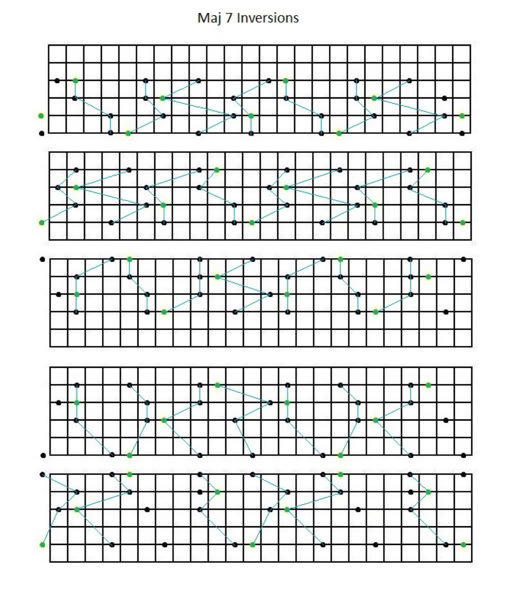
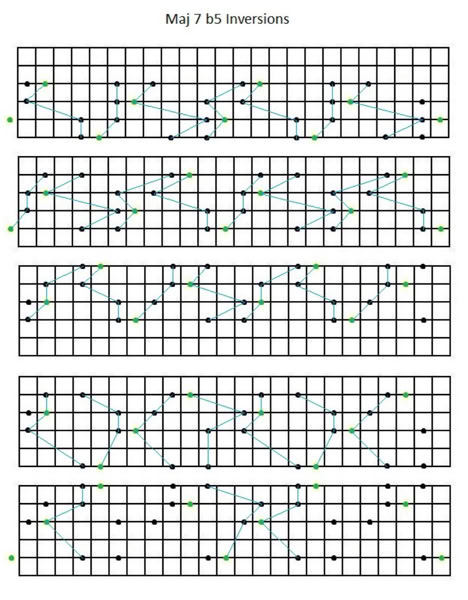
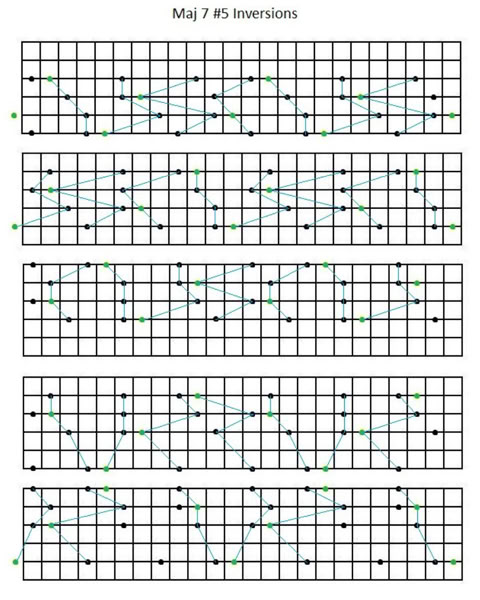

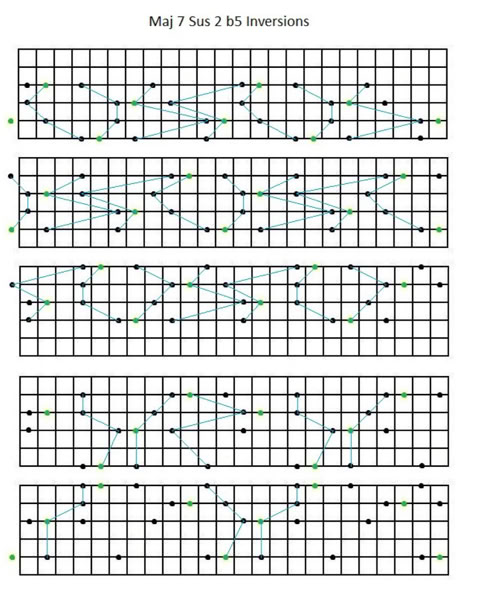
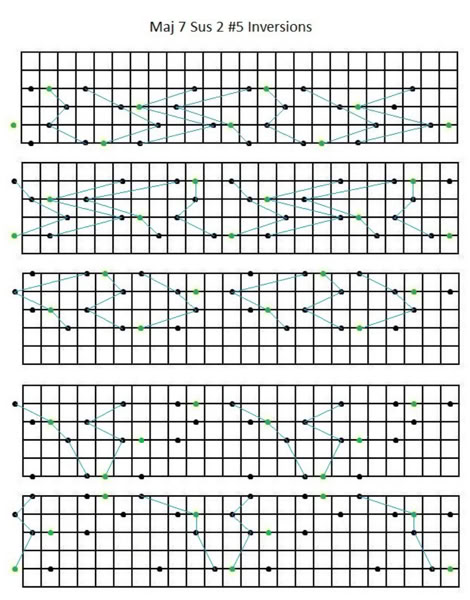
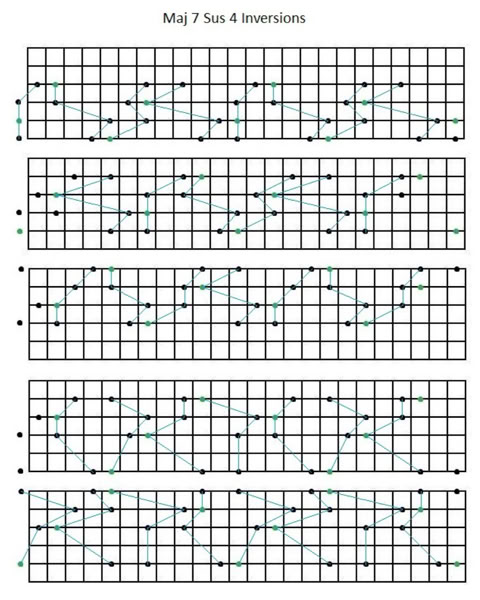

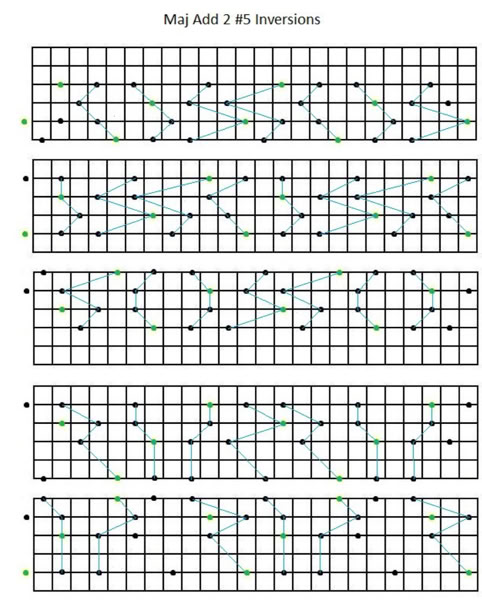
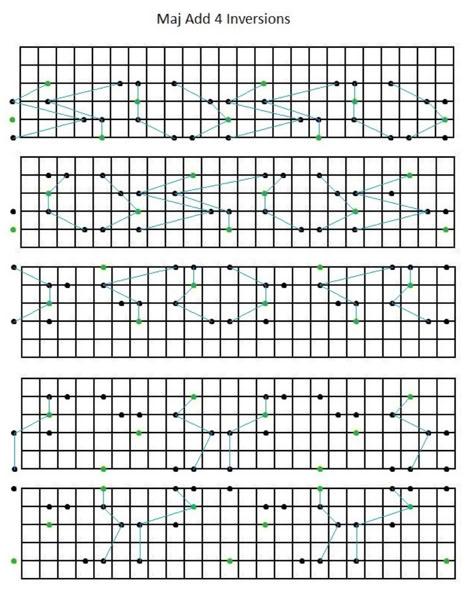

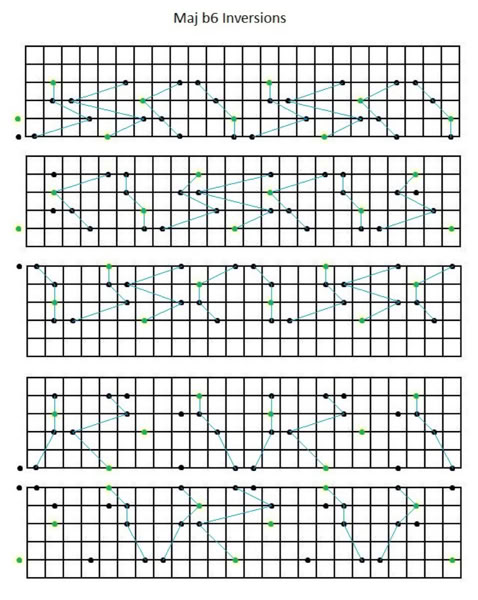
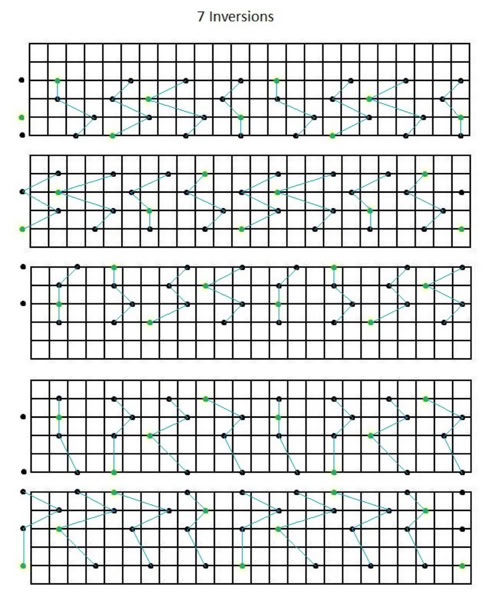

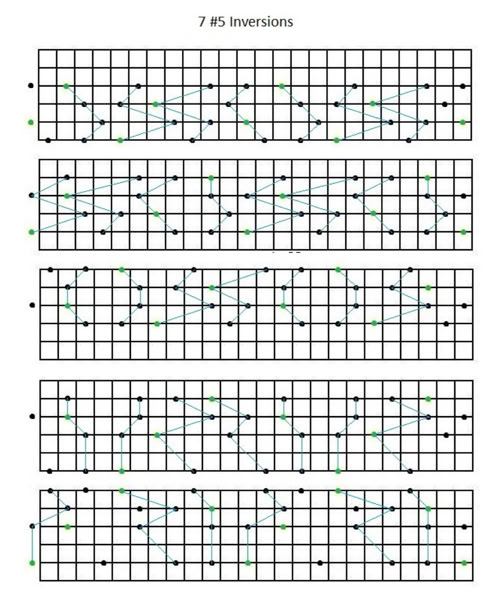
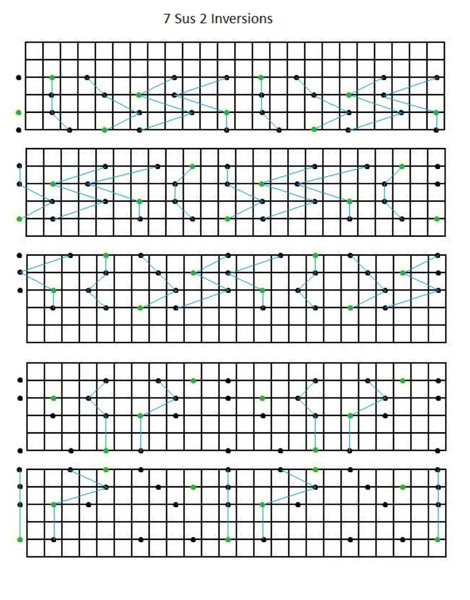
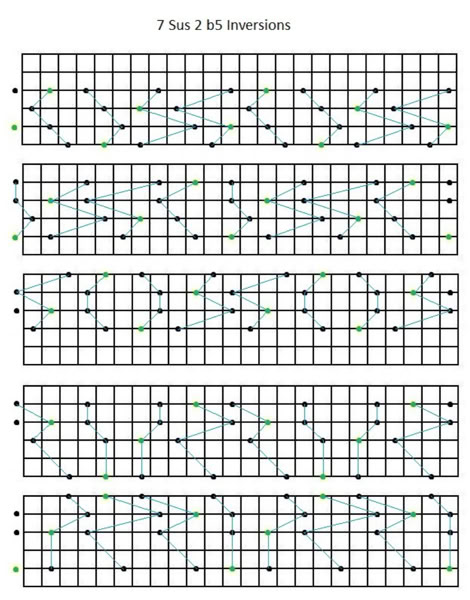
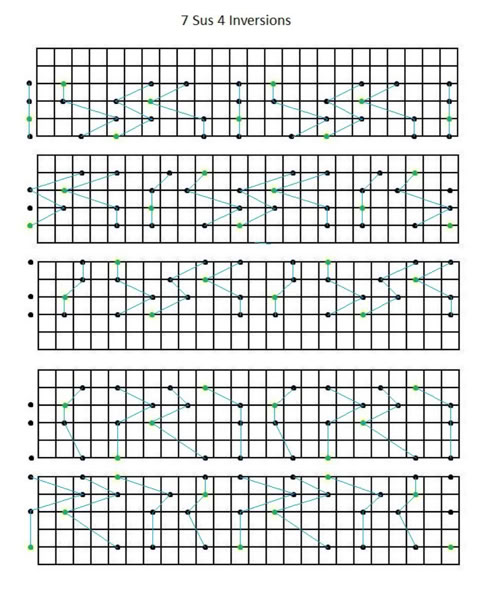
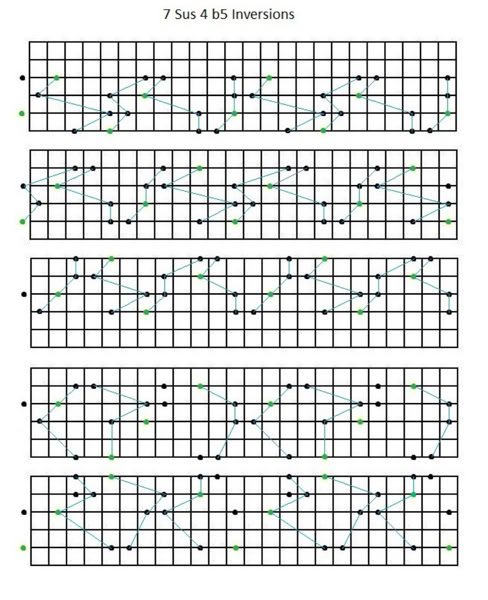


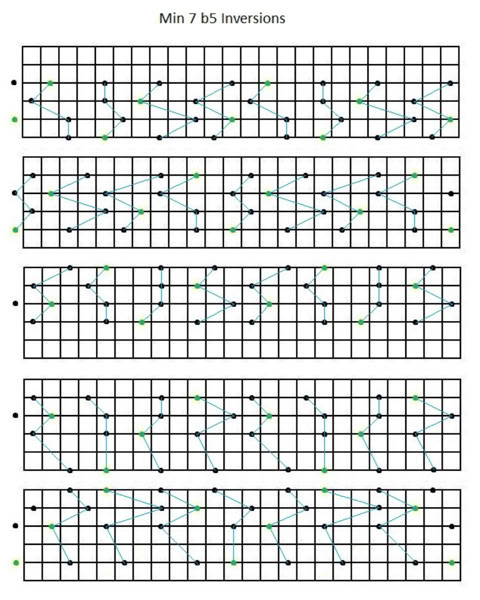


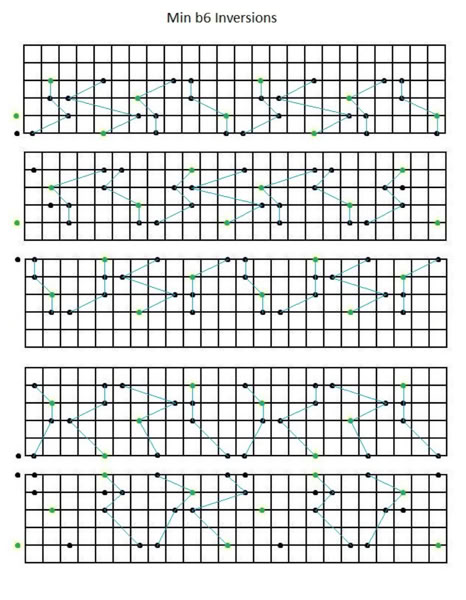
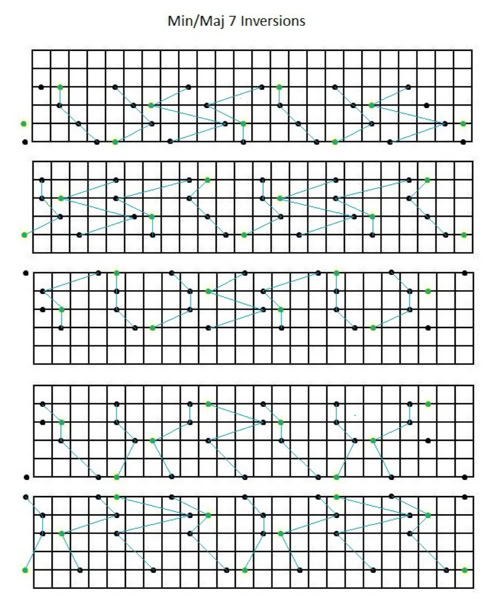

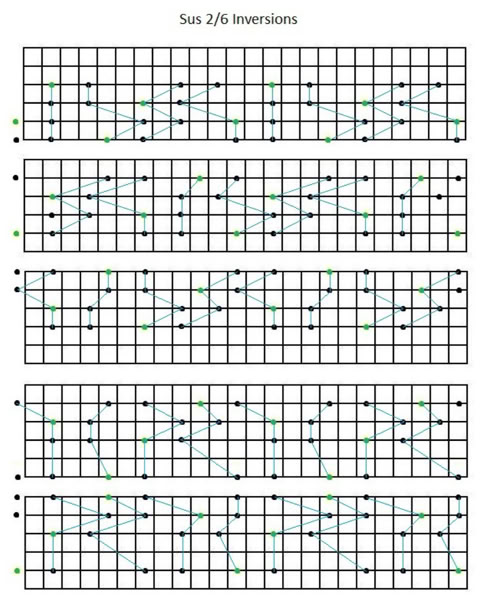
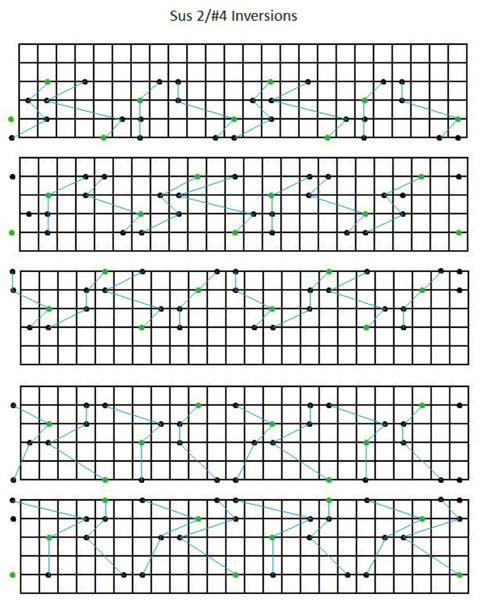

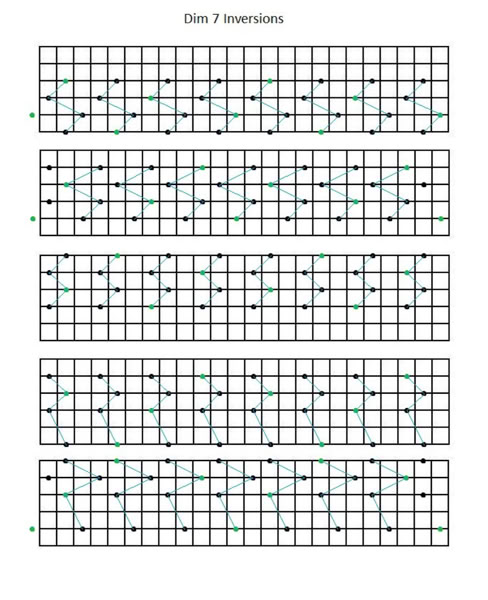
5 Note Chords

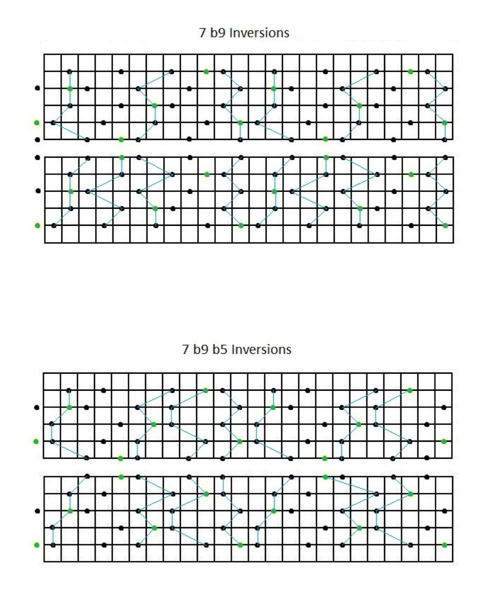
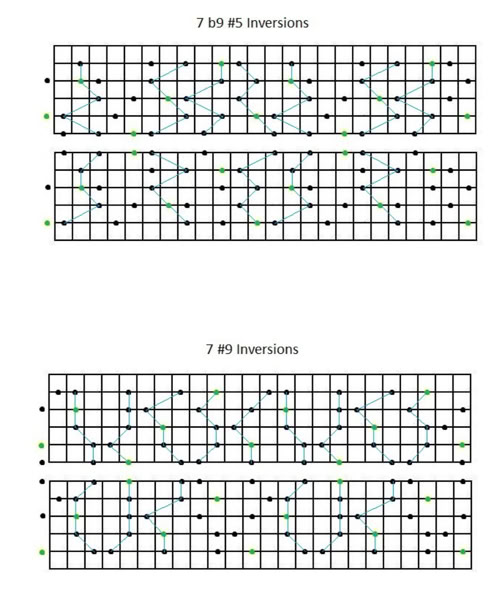



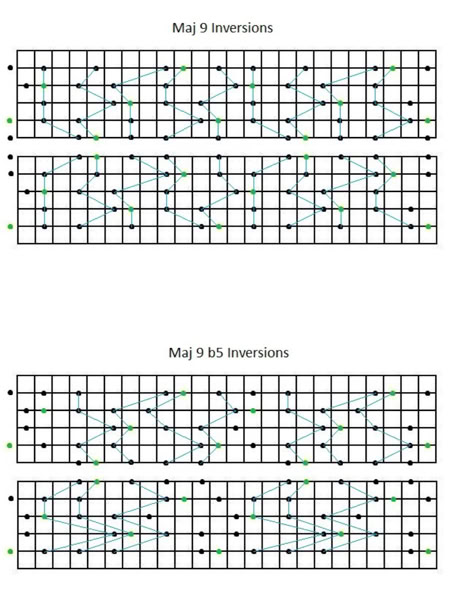
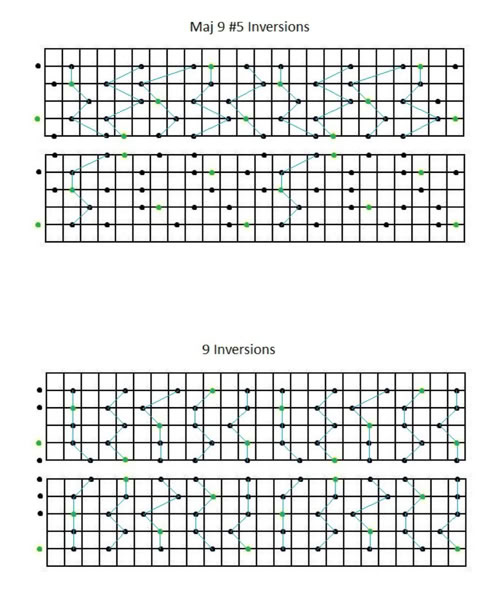

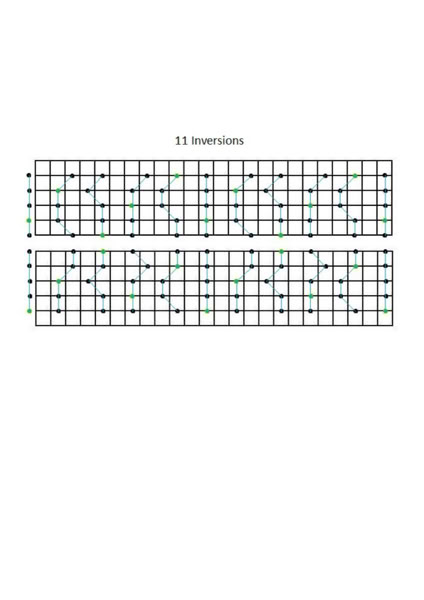
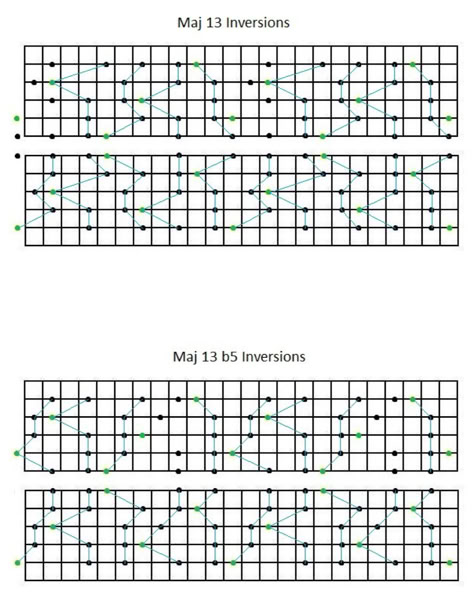
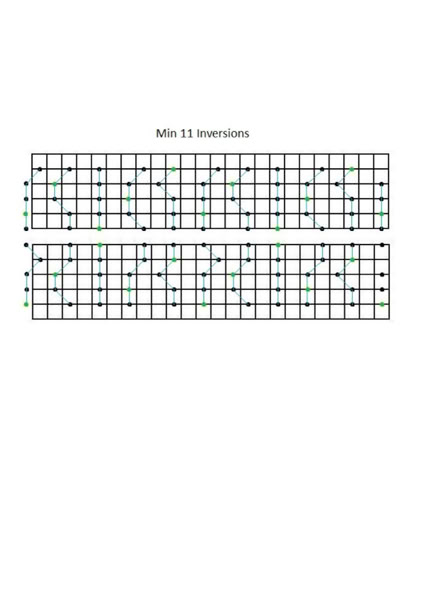
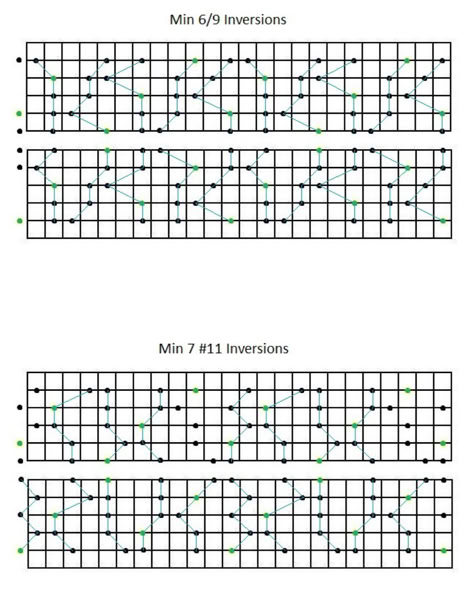
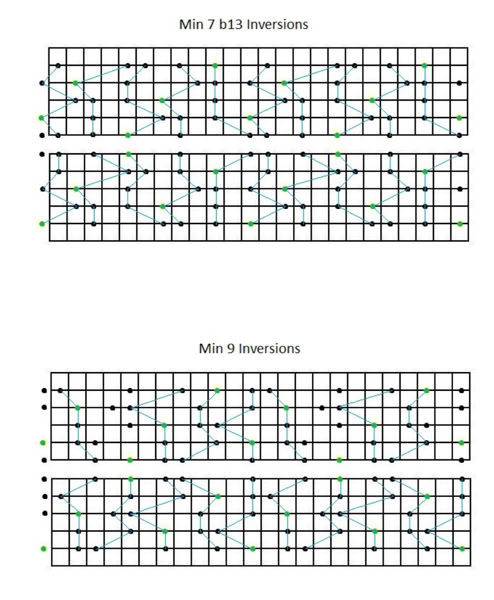
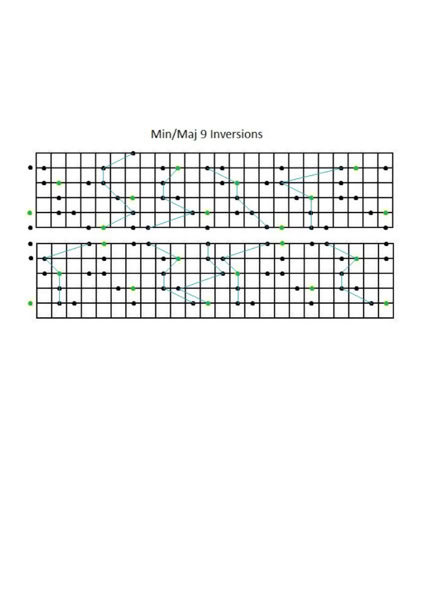
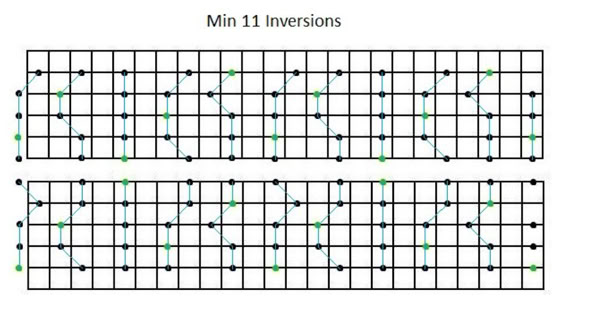
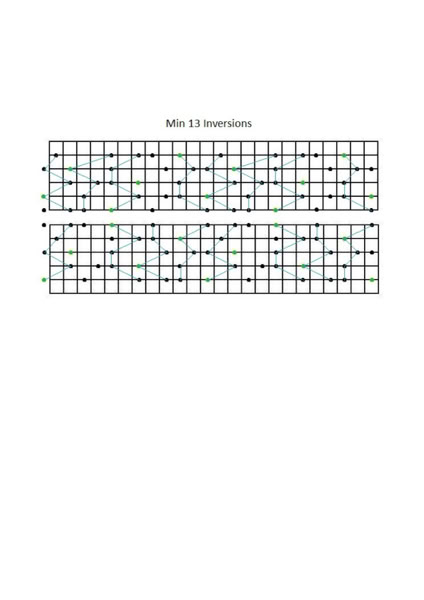
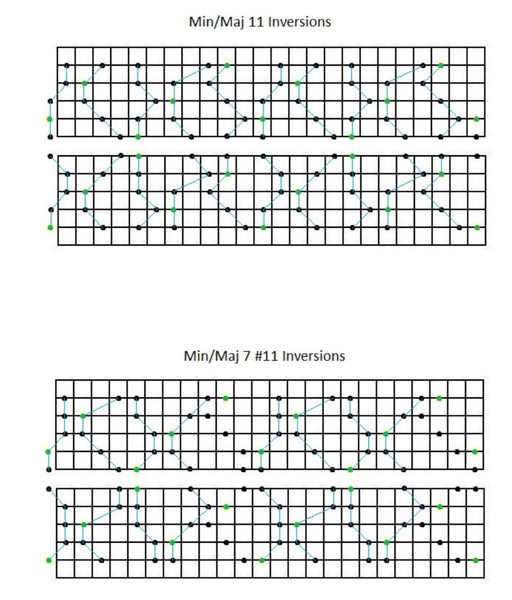
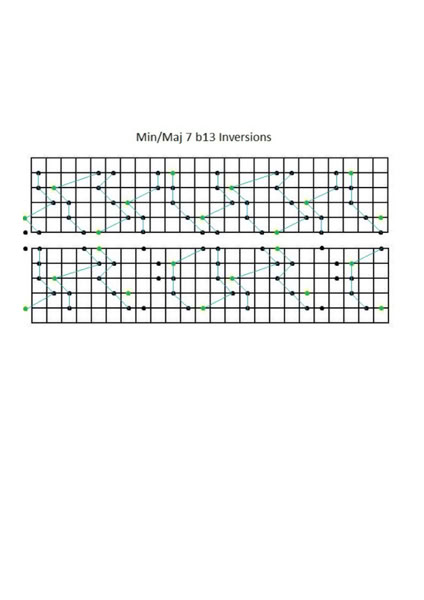
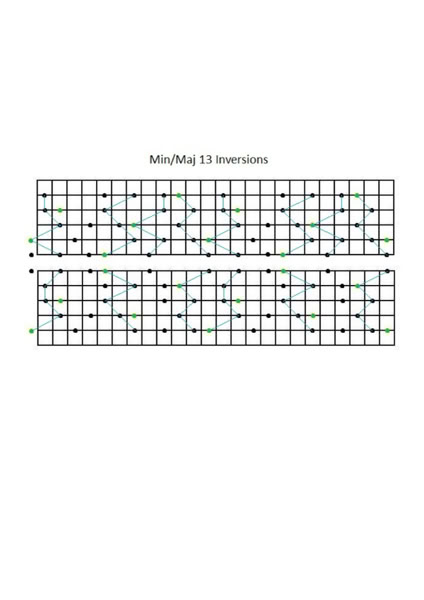
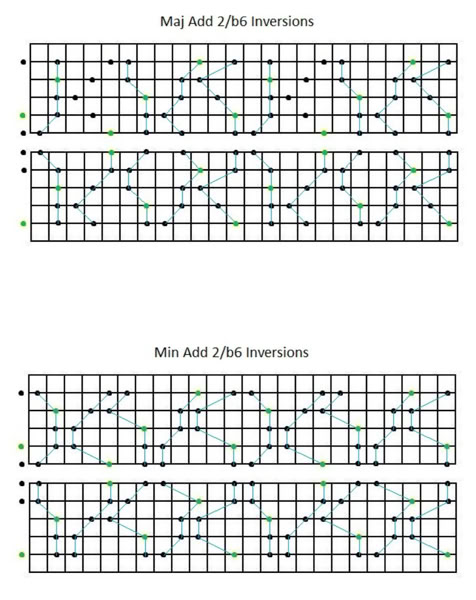


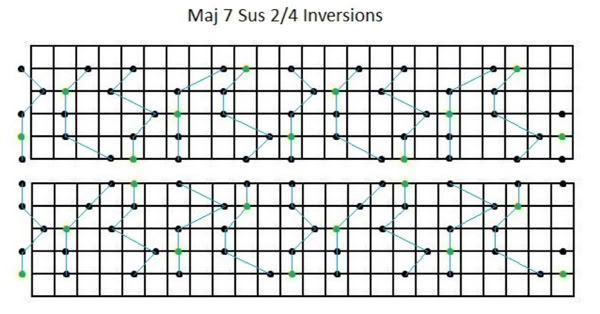

6 Note Chords
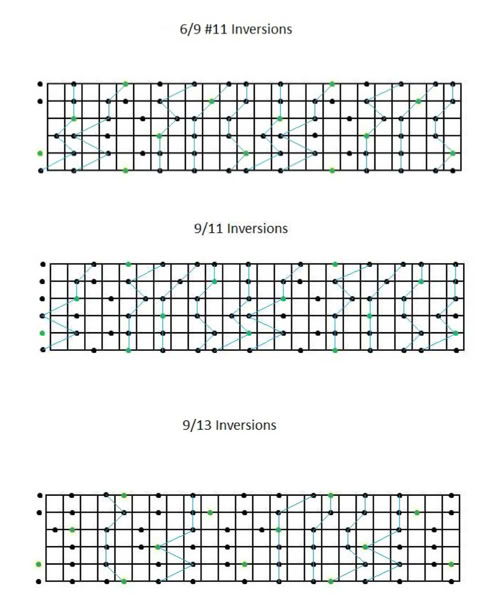

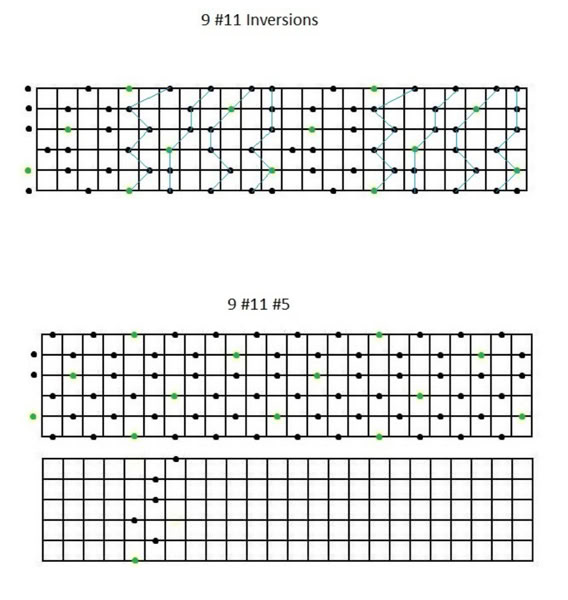

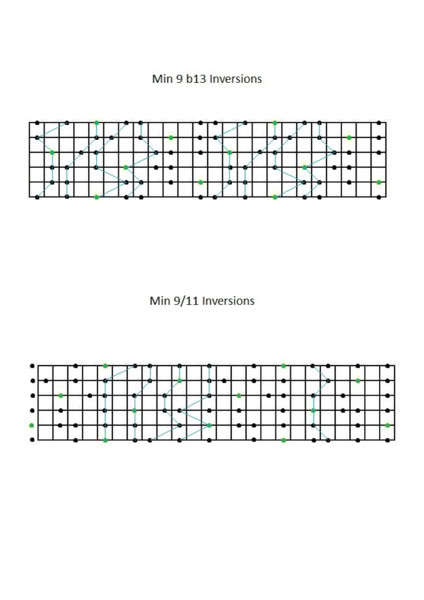
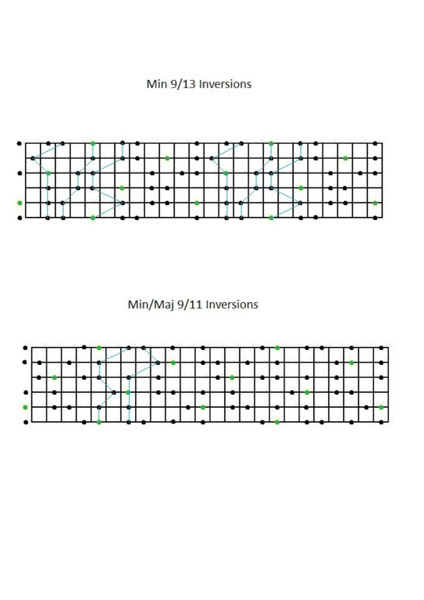
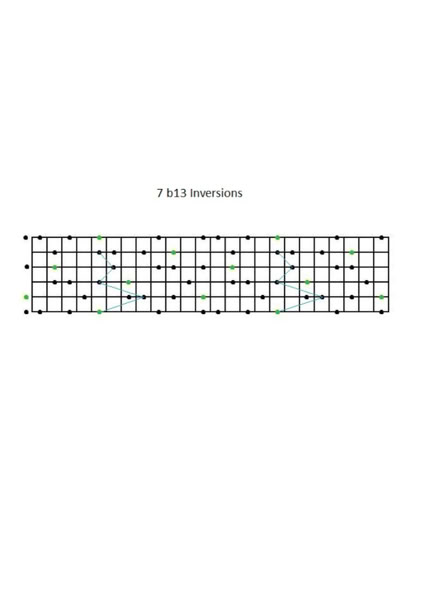
Examples Of Arpeggios That Exceed An Octave
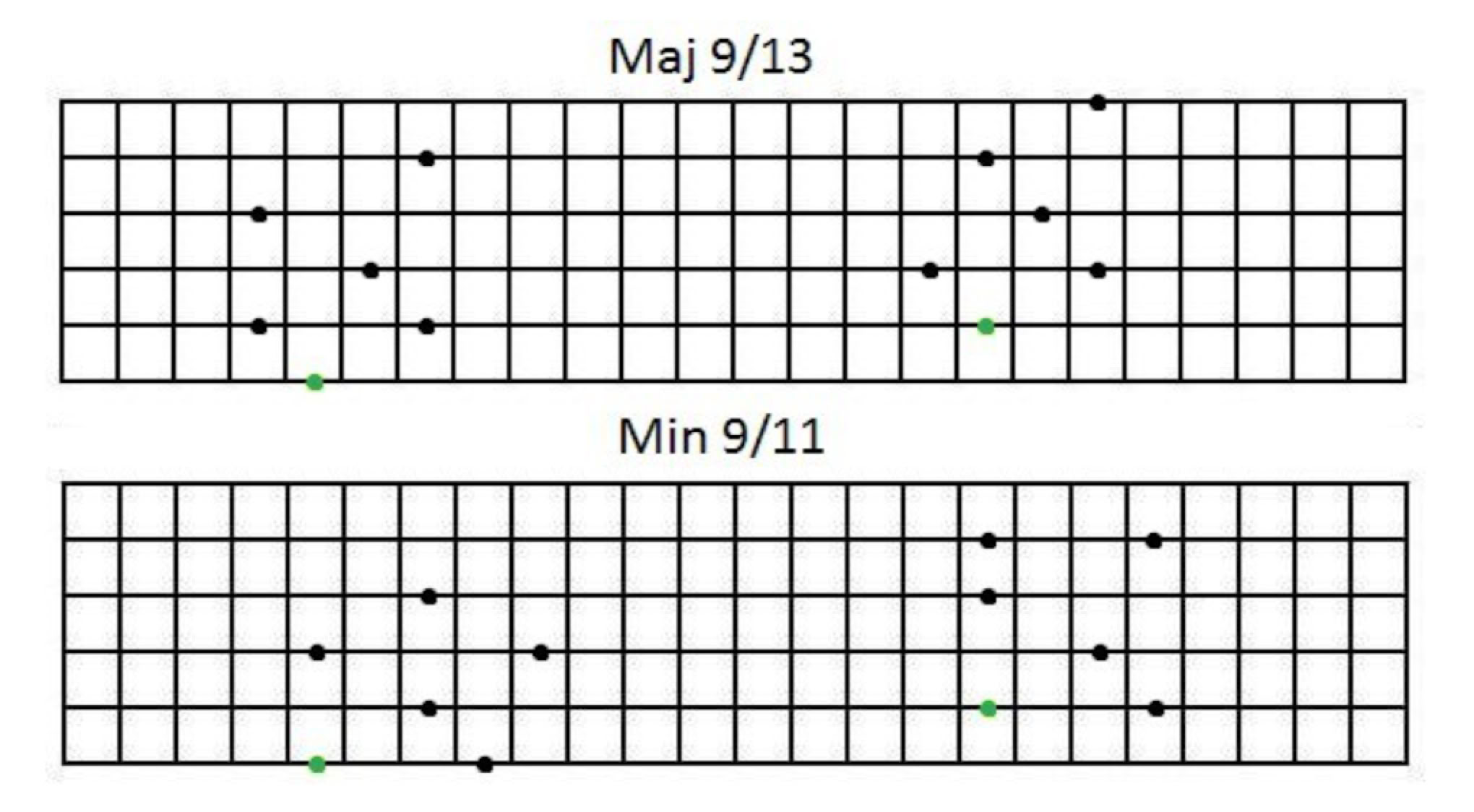
3 Note Arpeggios
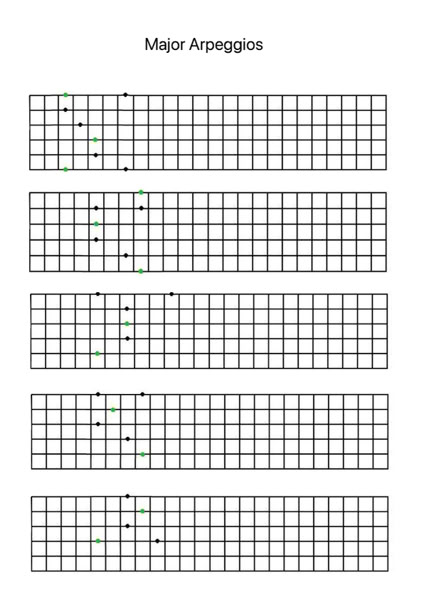

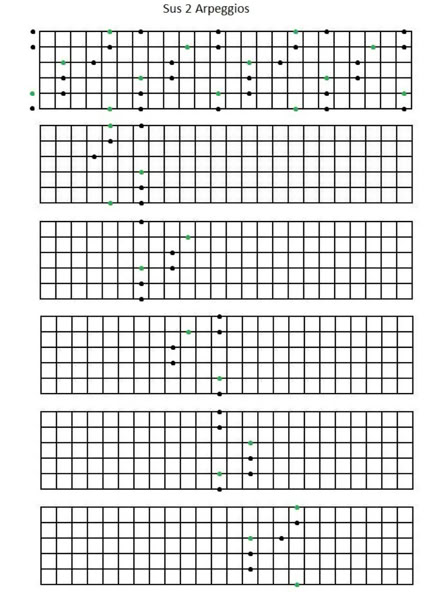
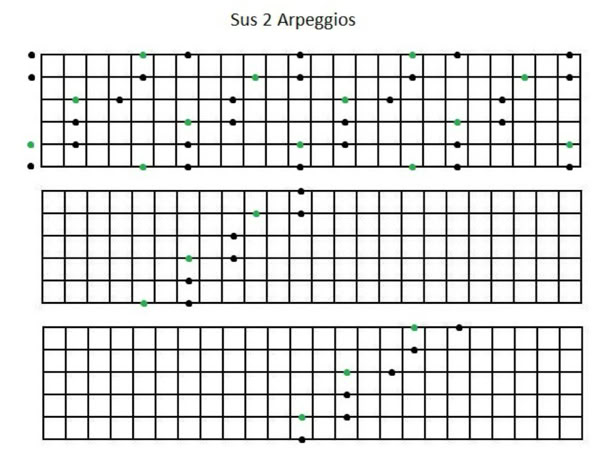

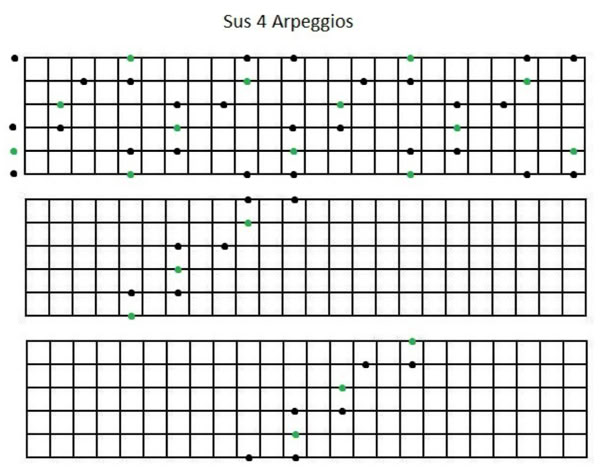
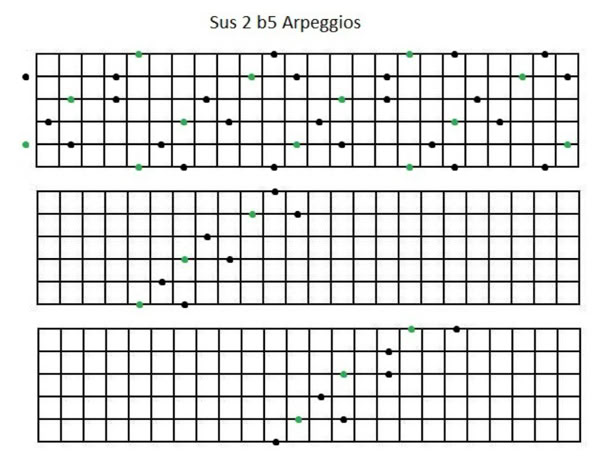
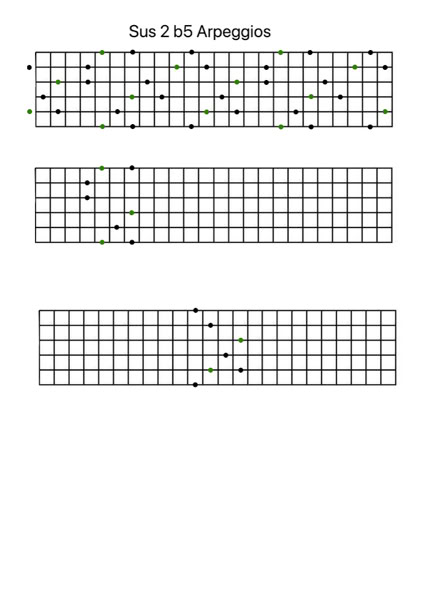
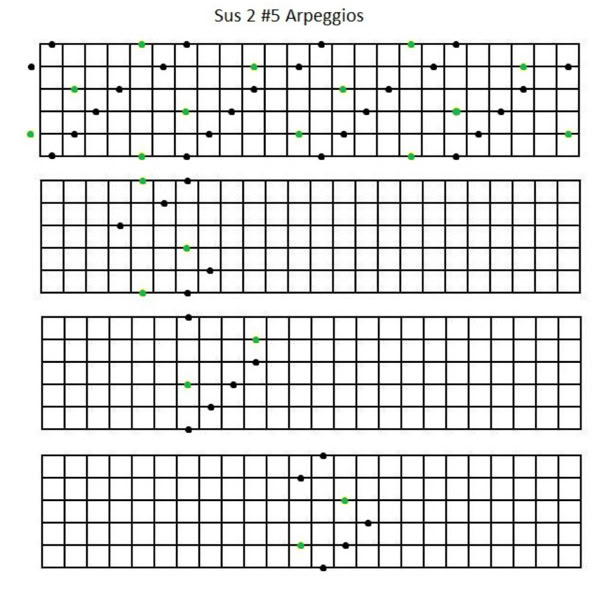
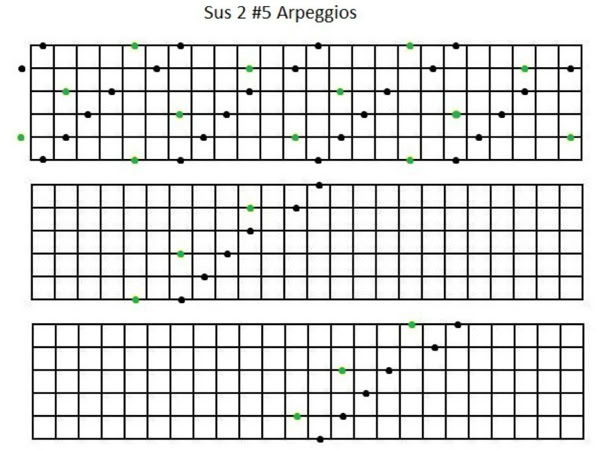
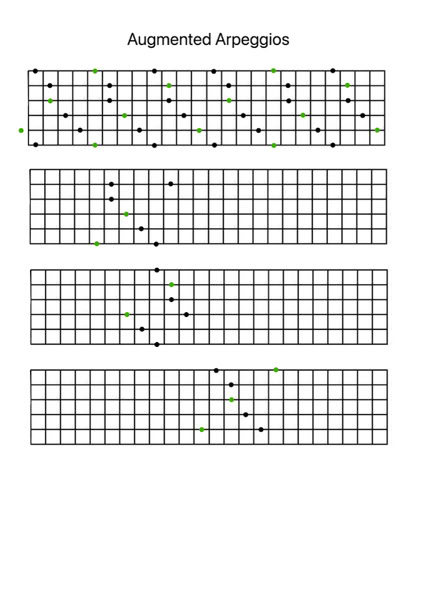
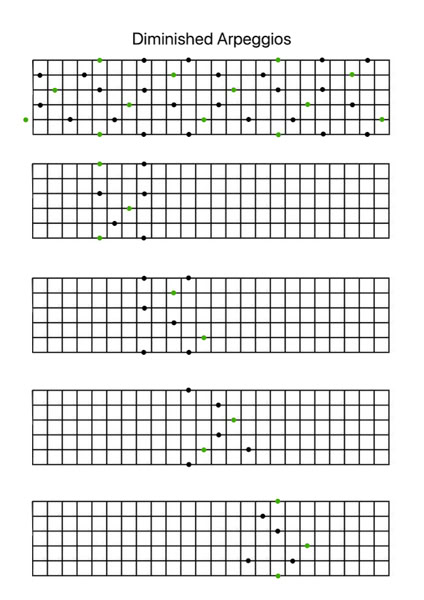

4 Note Arpeggios
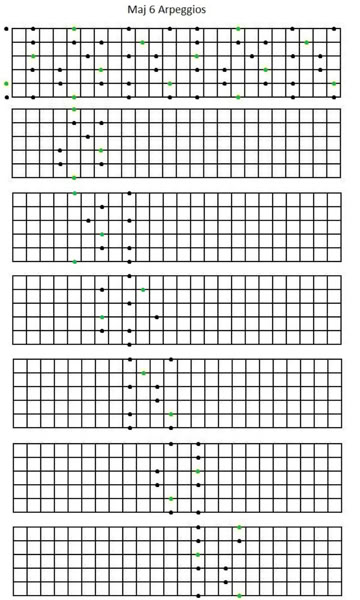
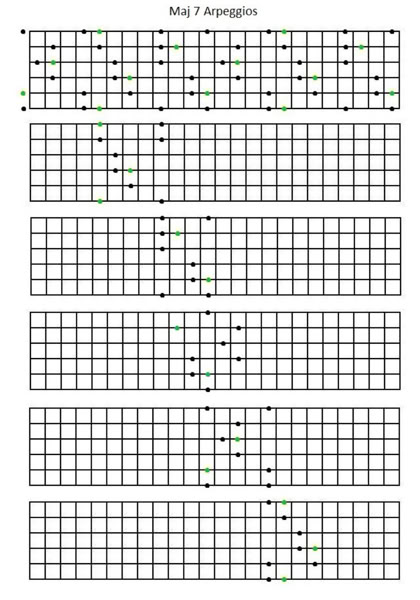


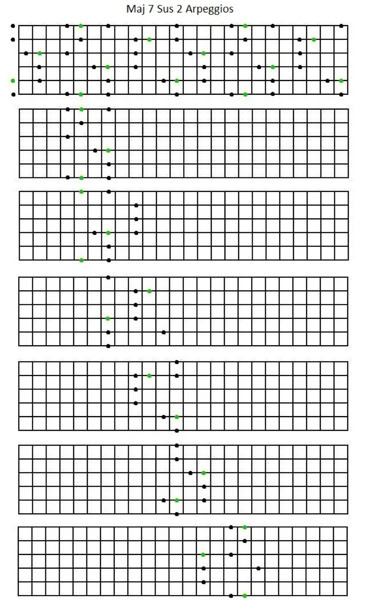
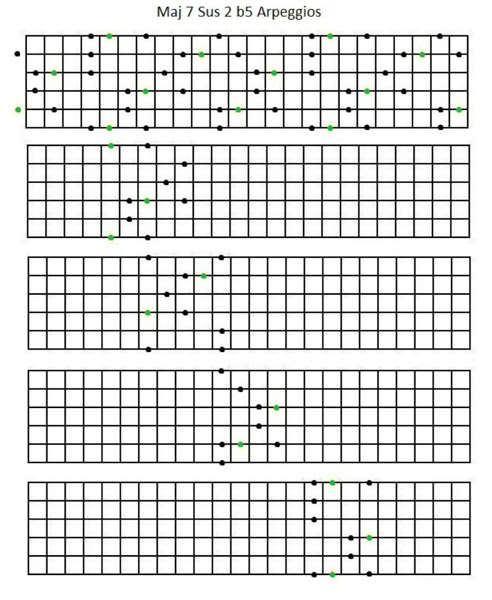
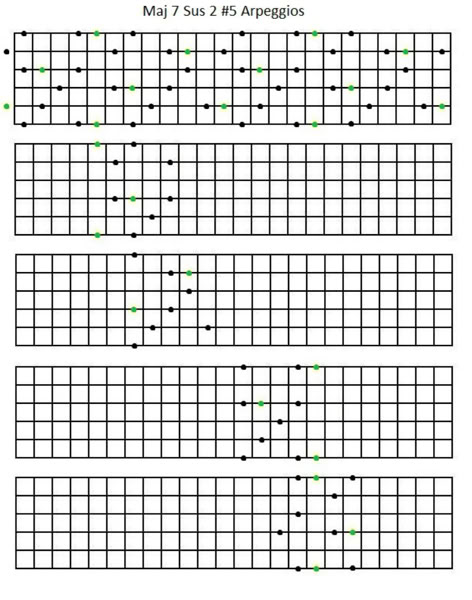


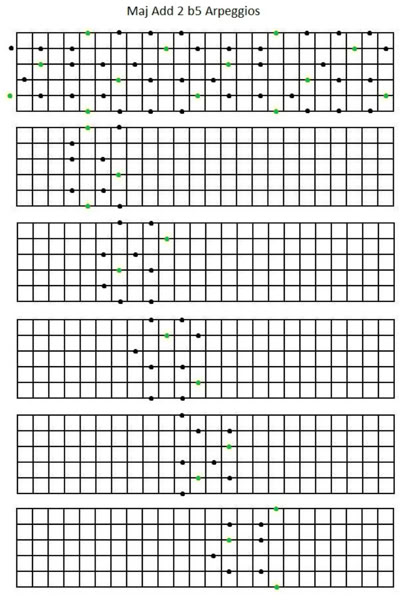
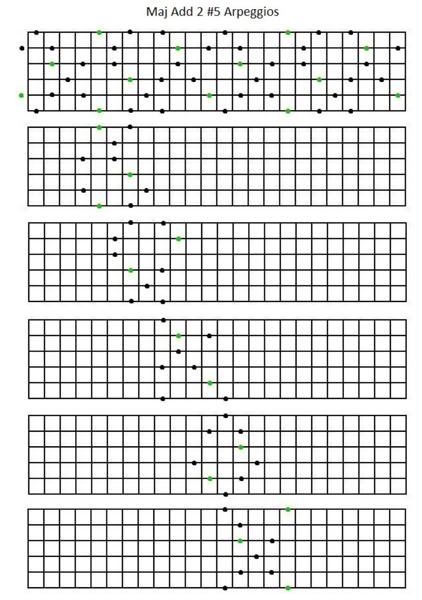

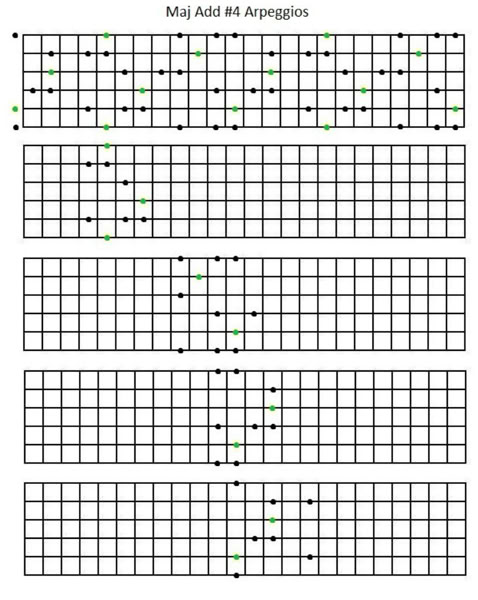

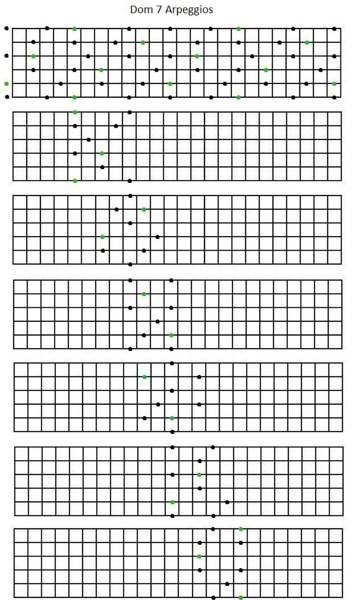
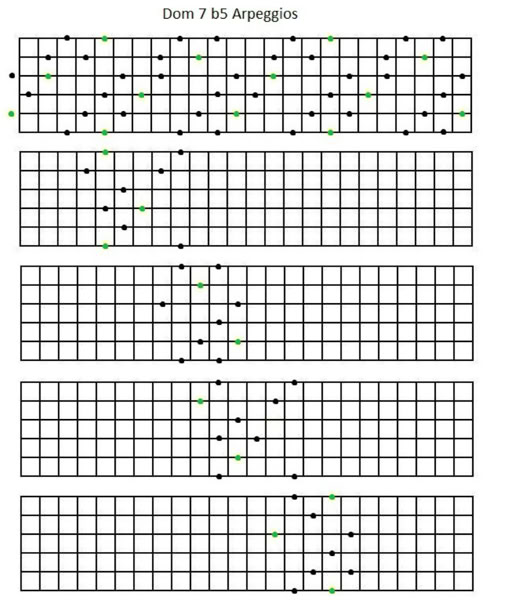
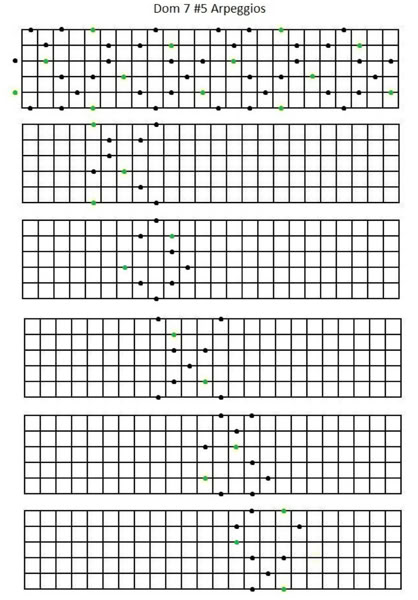


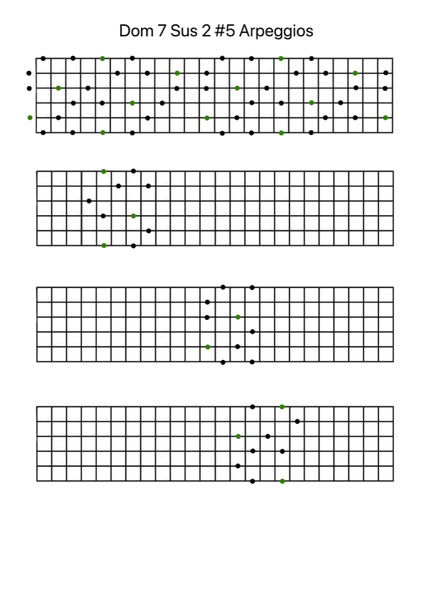
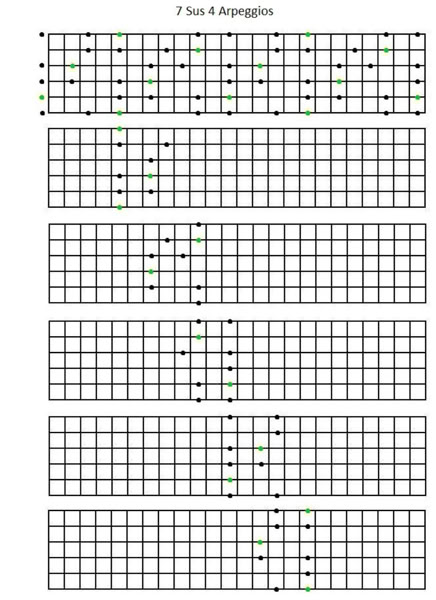

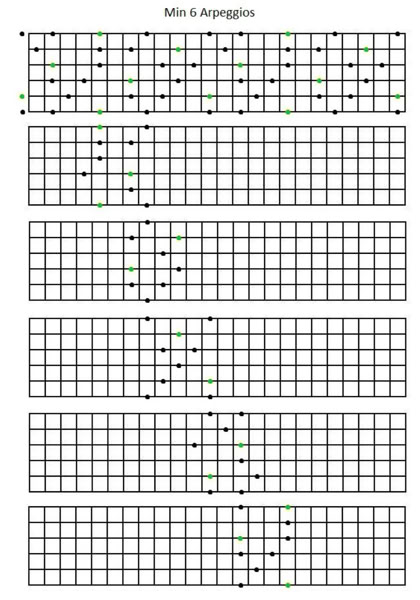
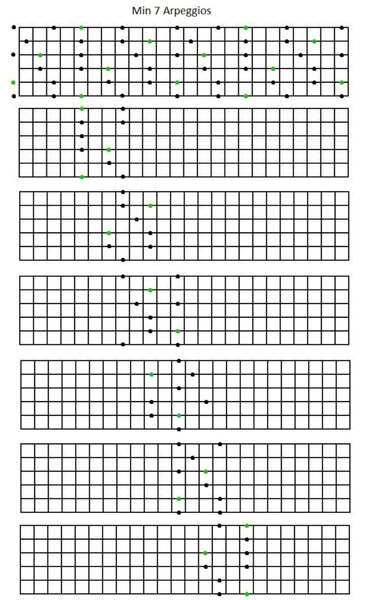
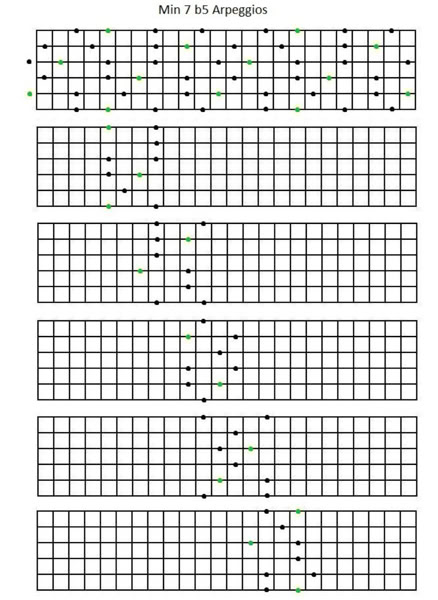
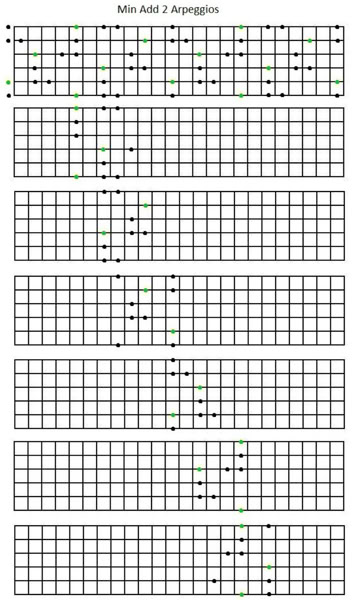


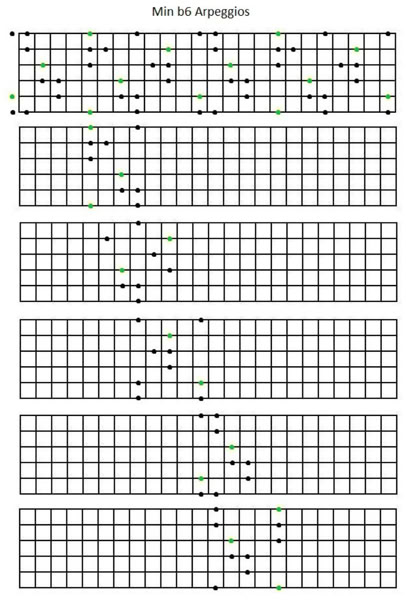
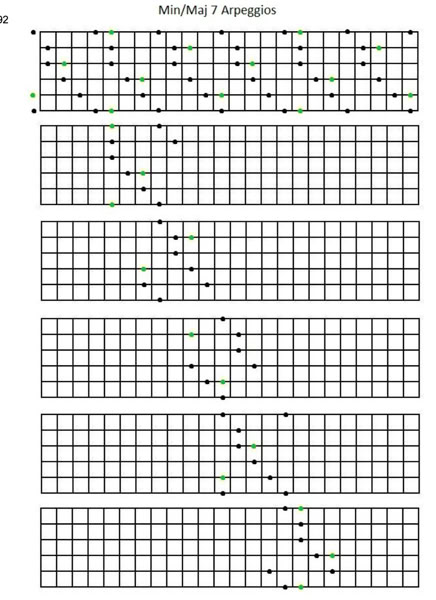

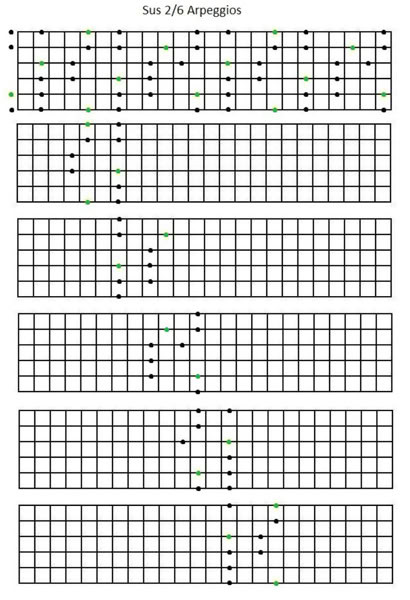
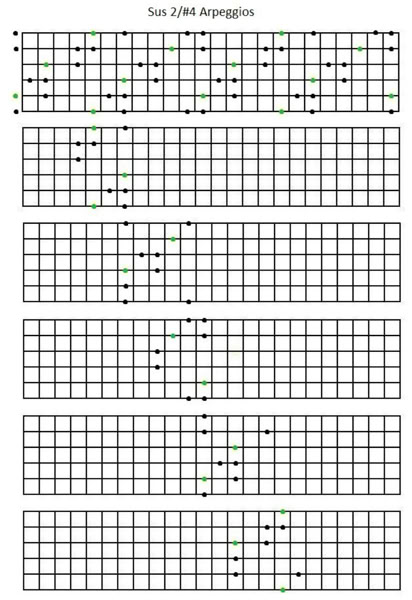


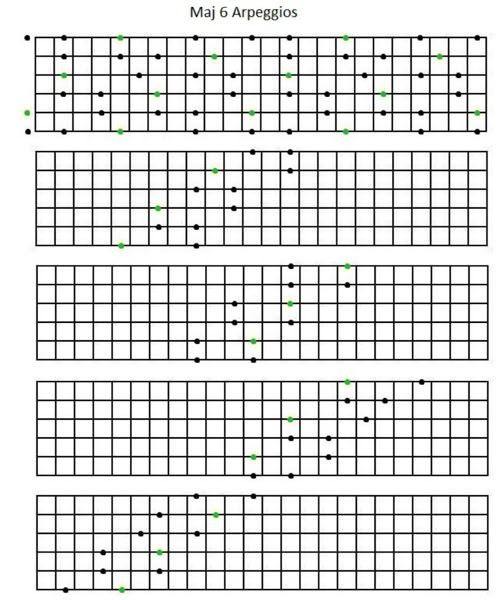
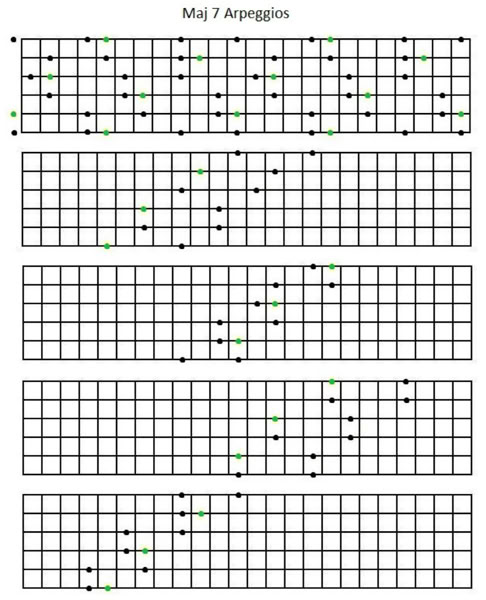

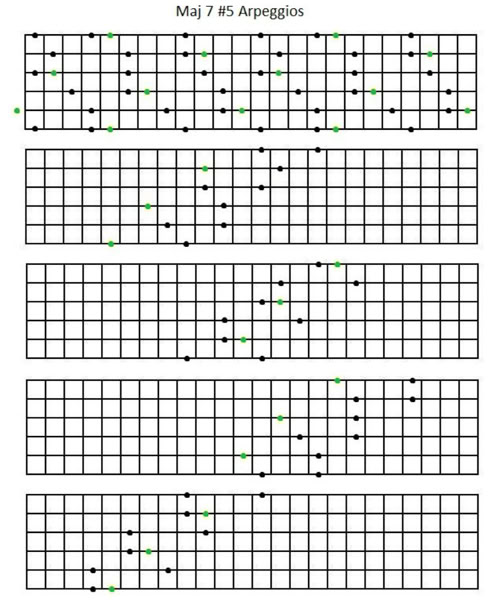


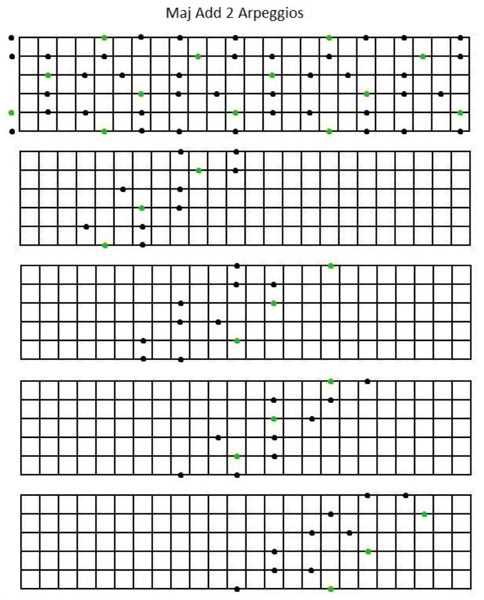


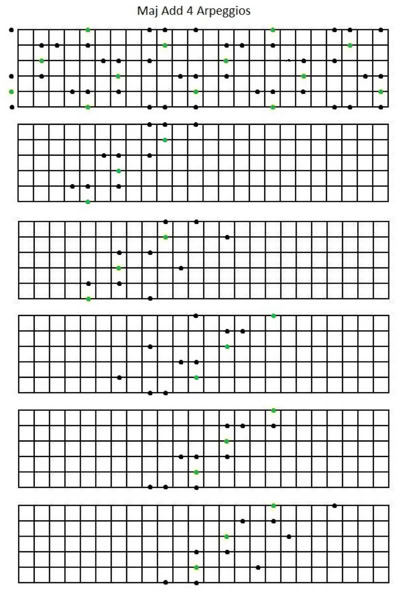

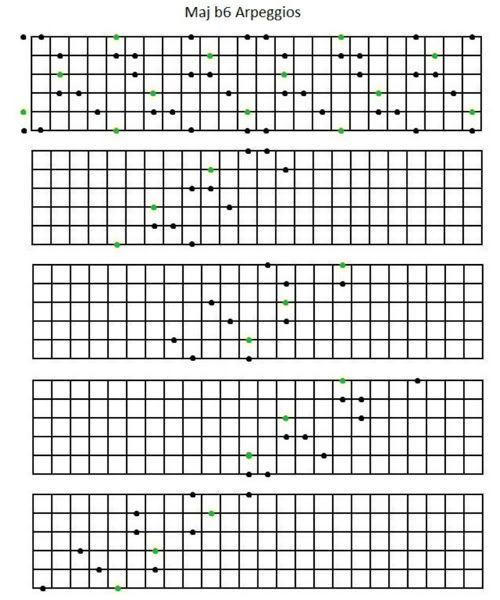
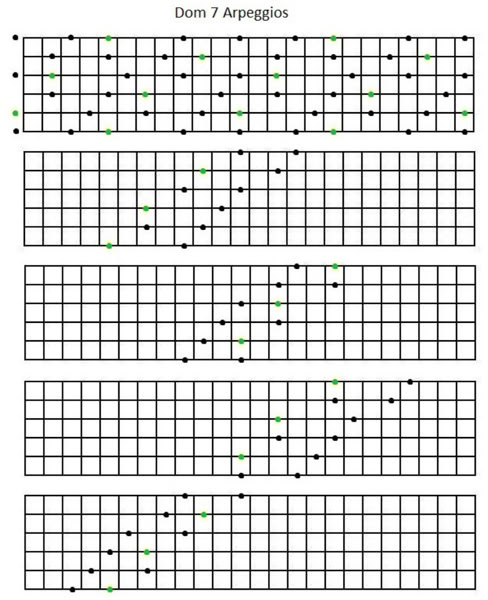

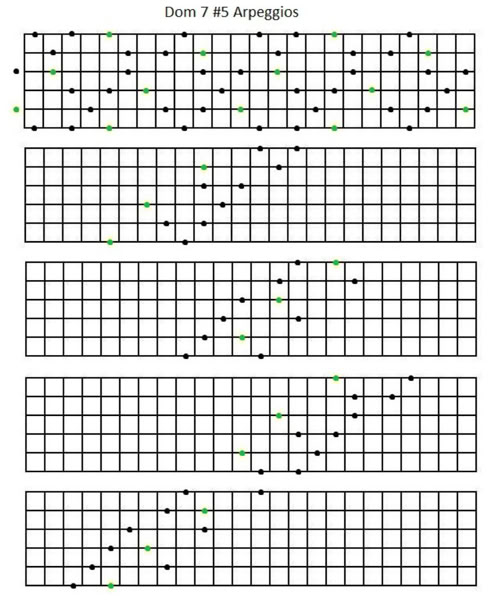

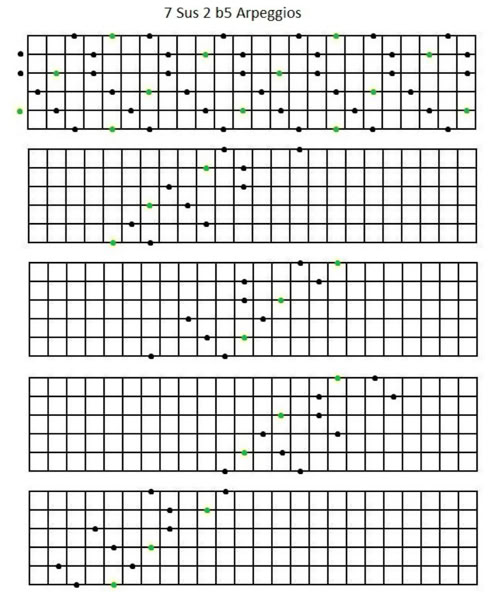


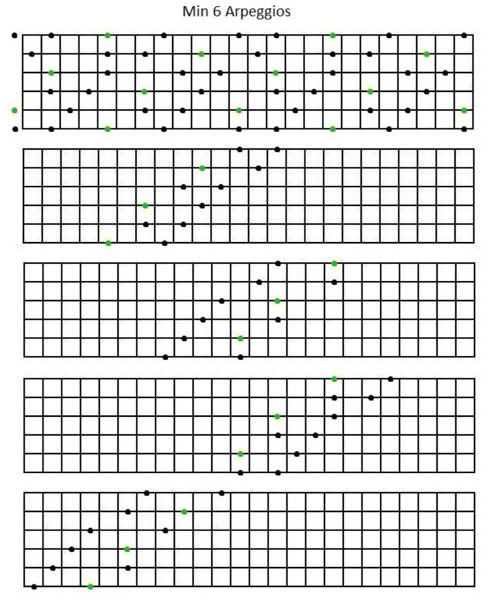
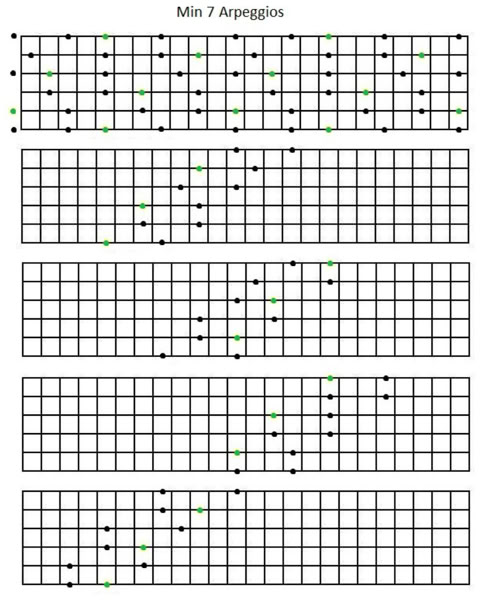

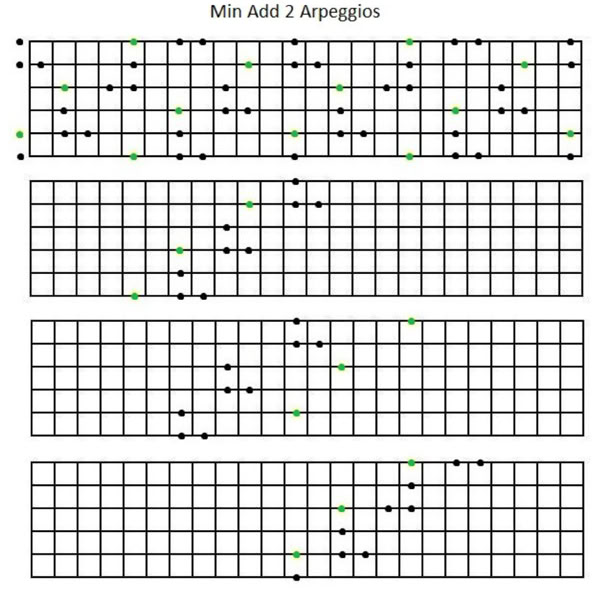
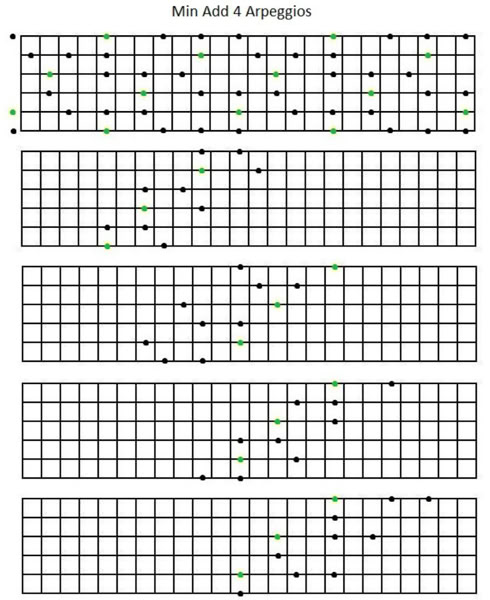
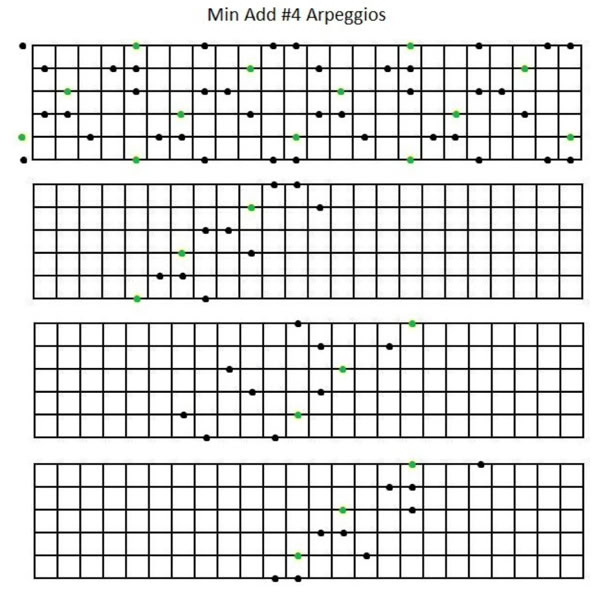
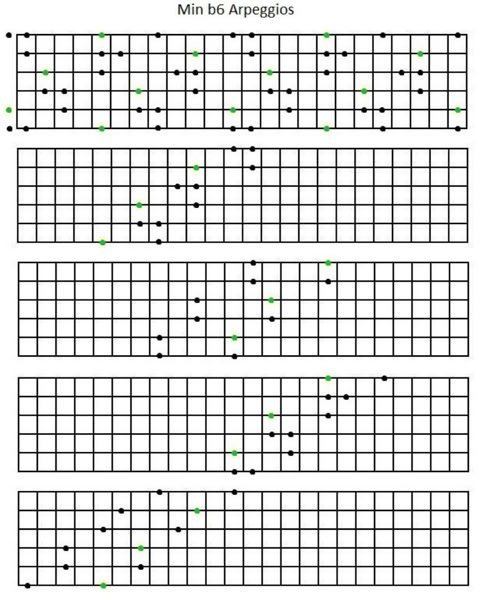
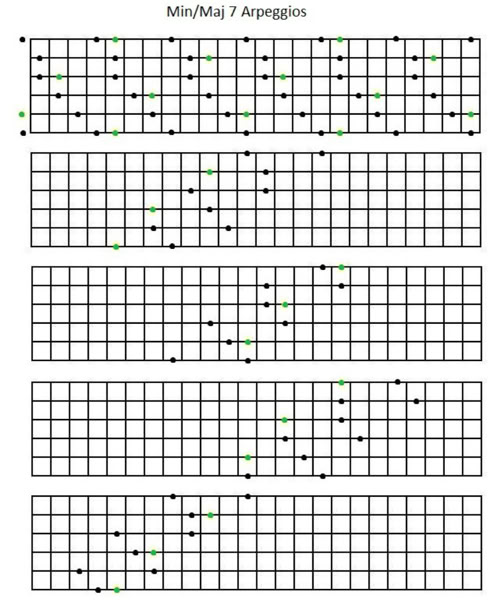
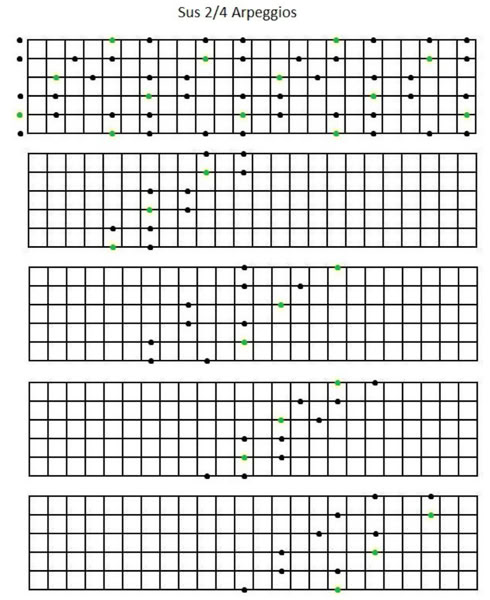



5 Note Arpeggios
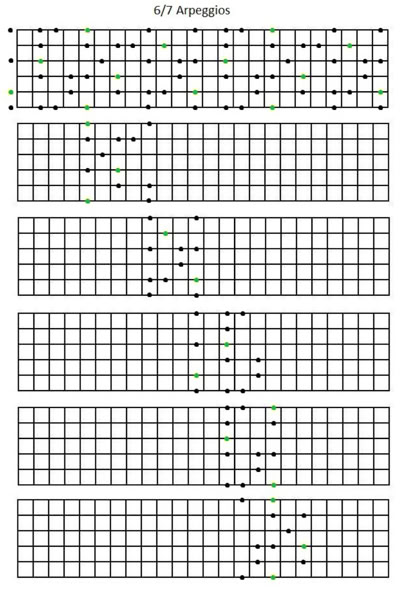


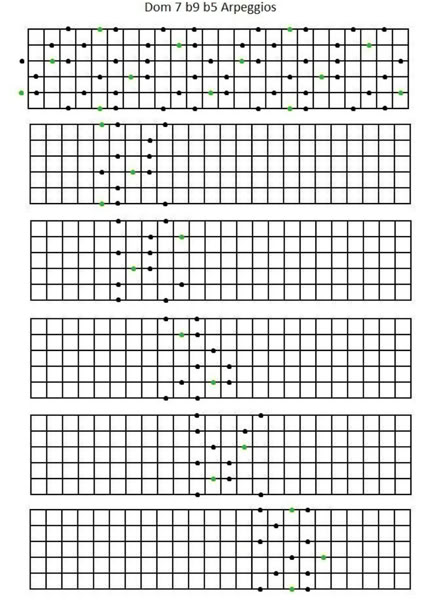

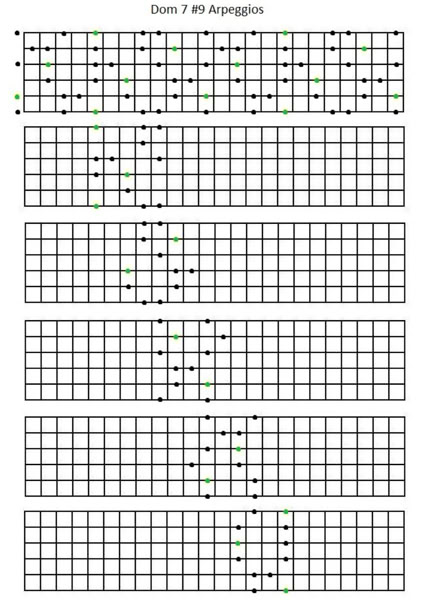
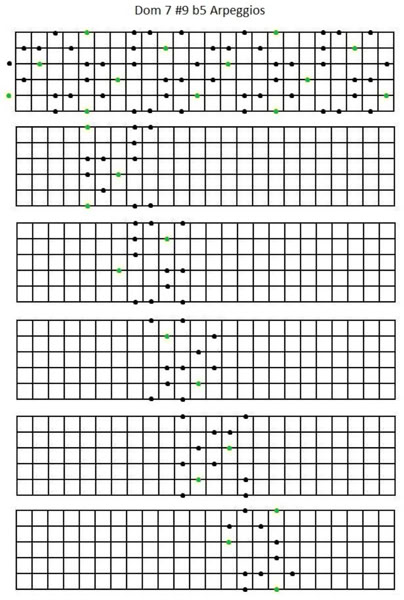
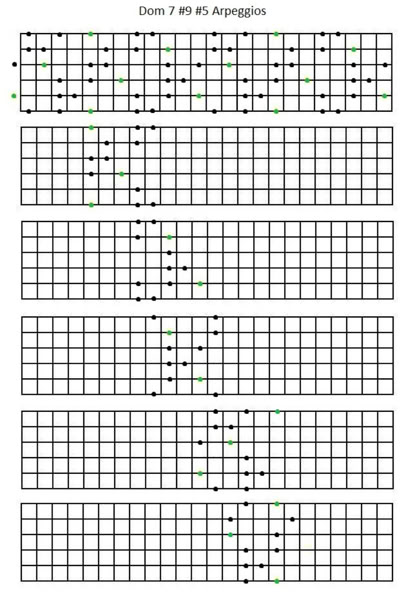

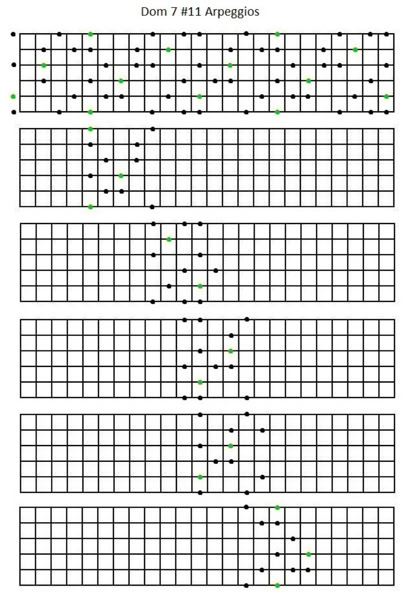

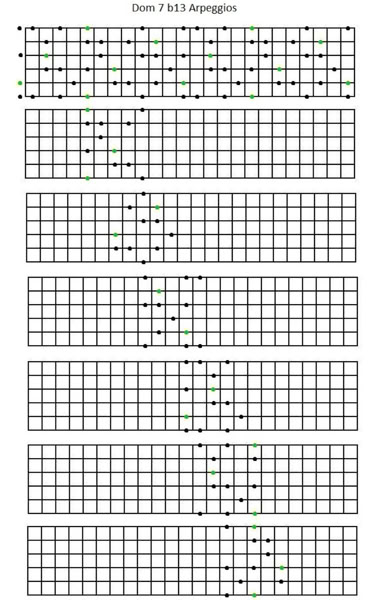


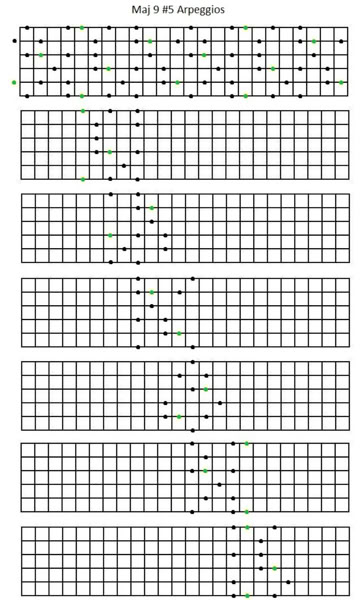

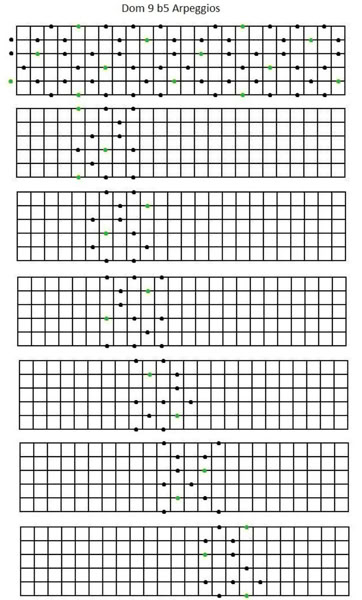

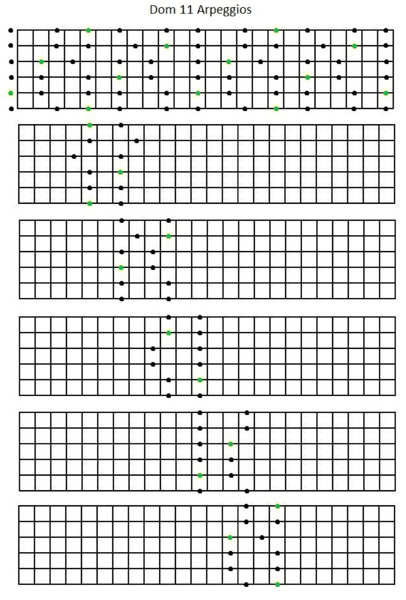

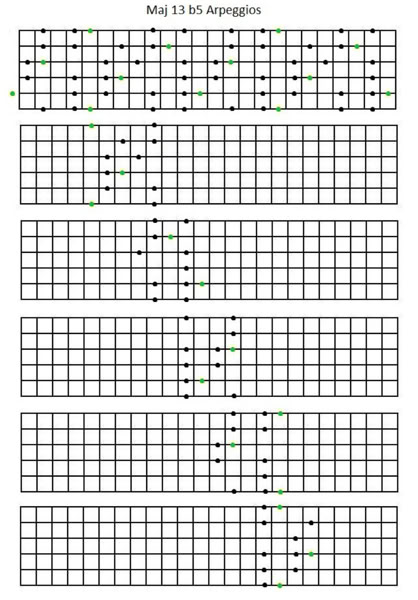
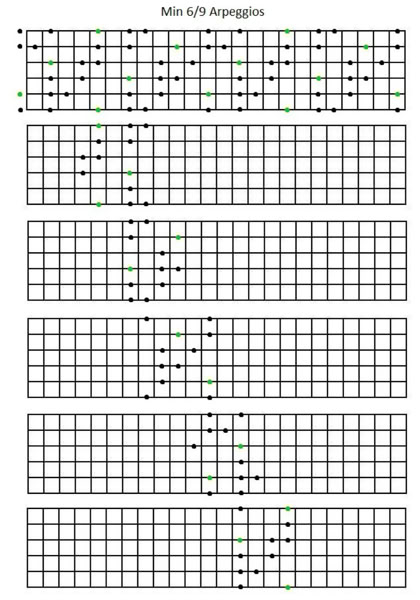
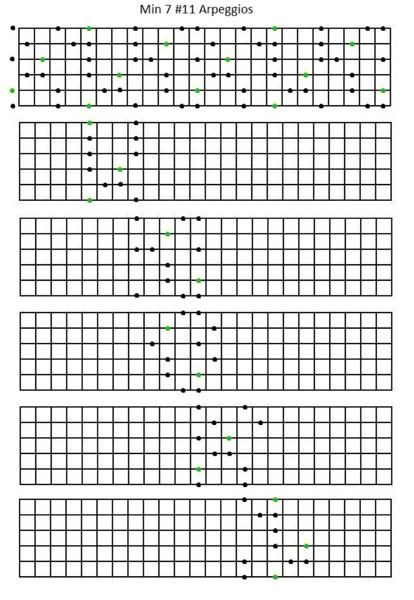
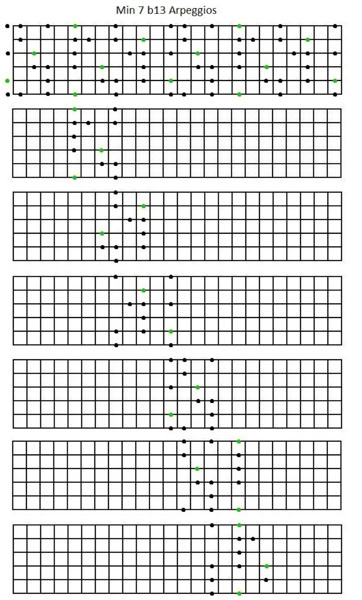
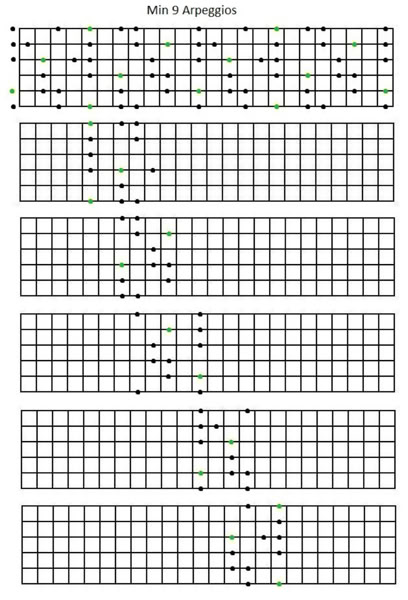
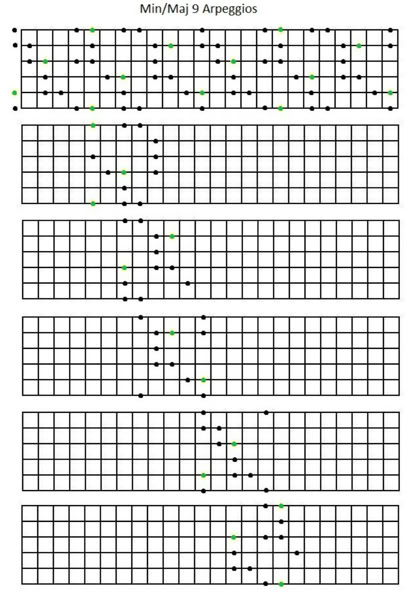

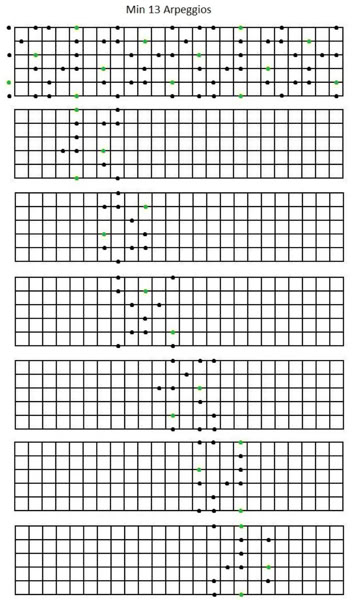


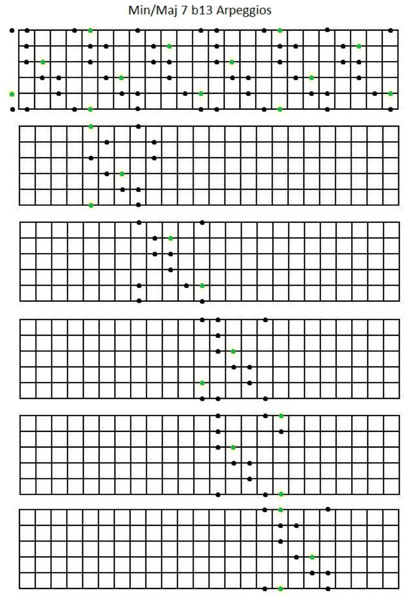
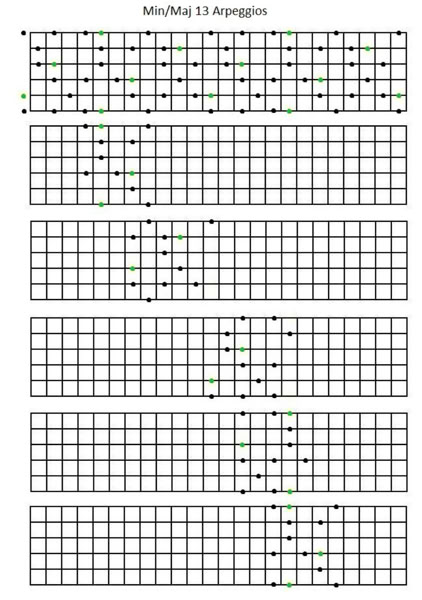



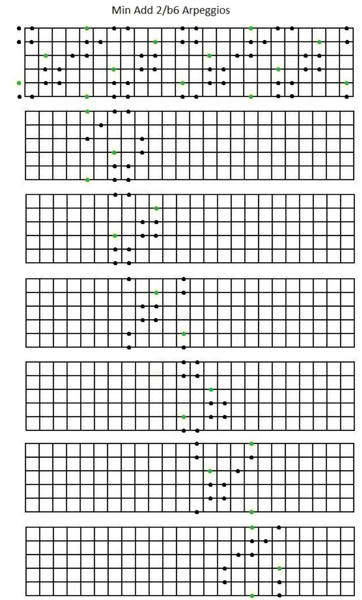
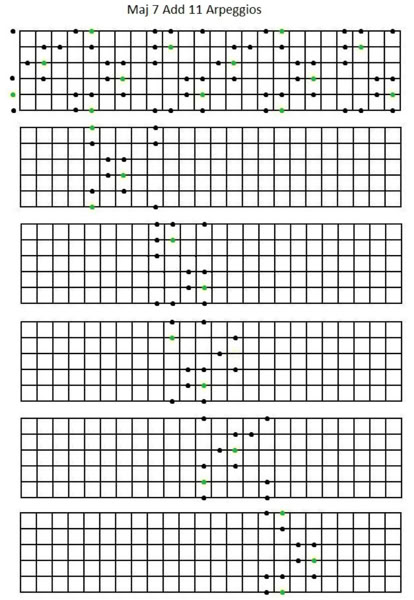

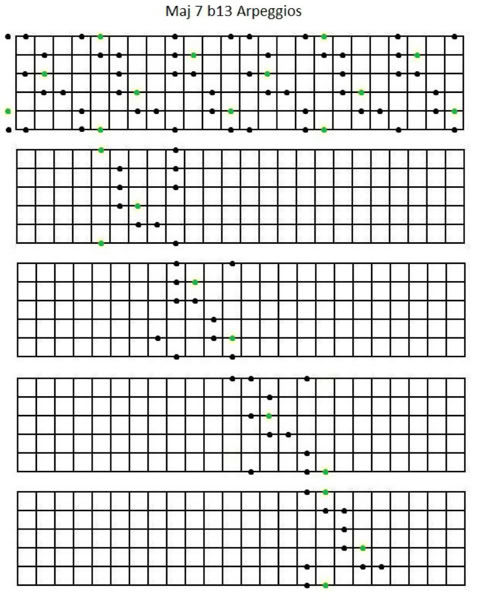
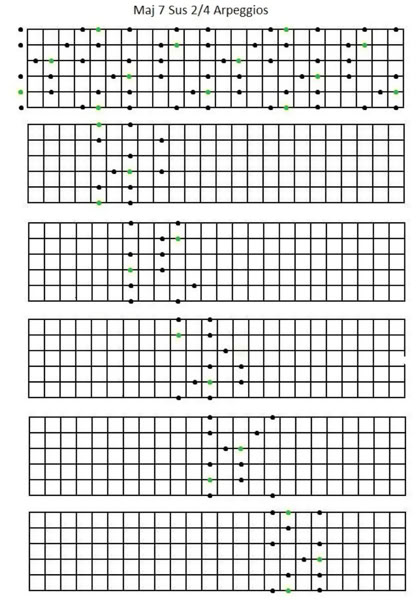
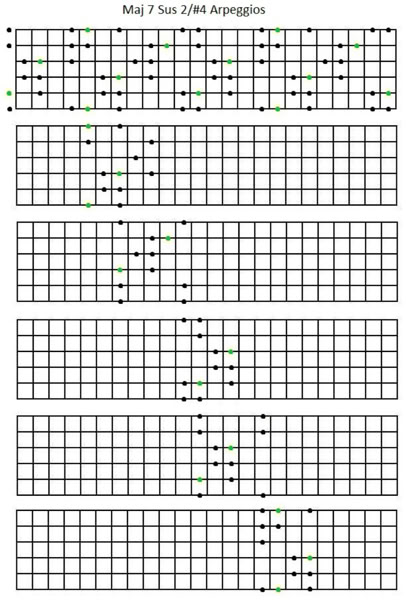
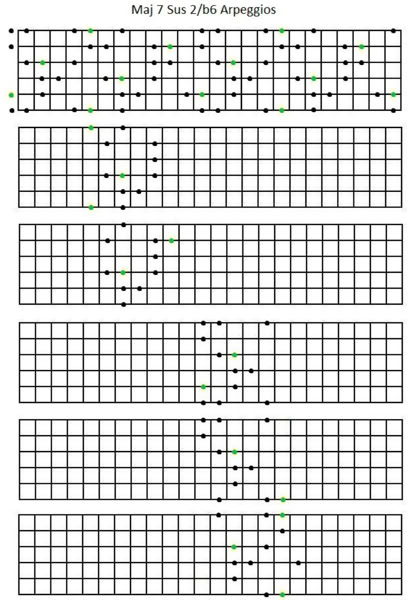
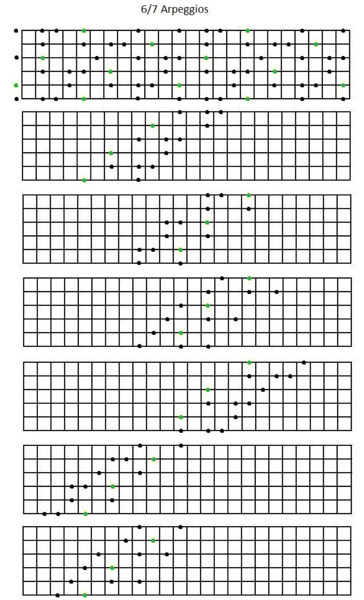
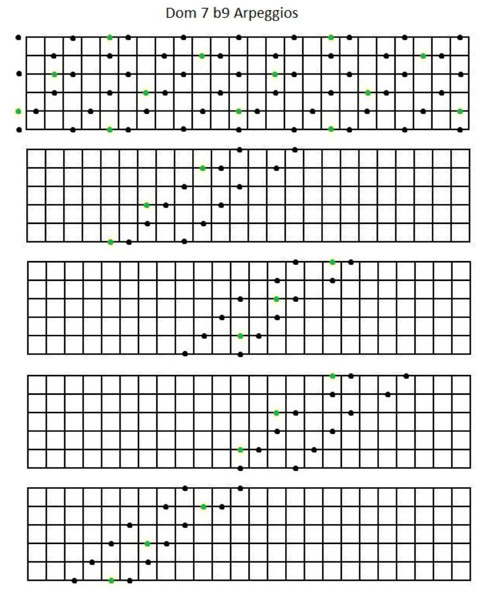
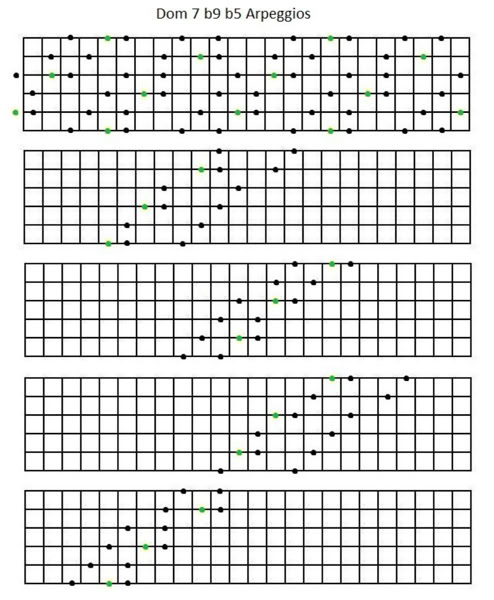
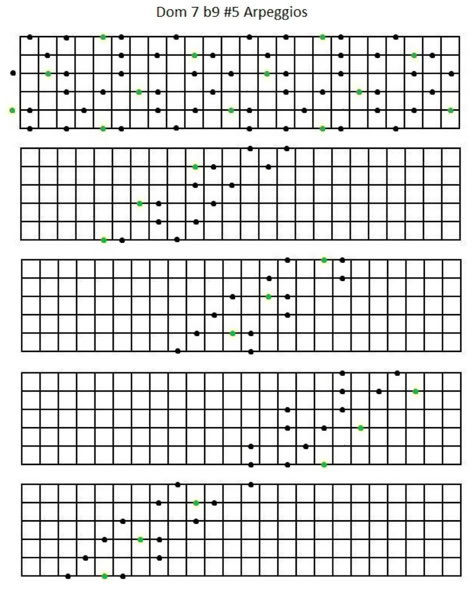


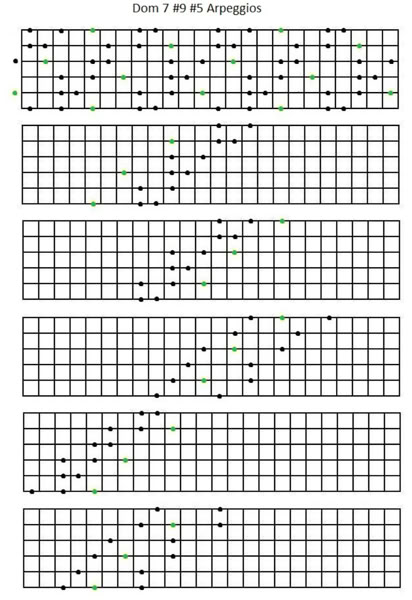
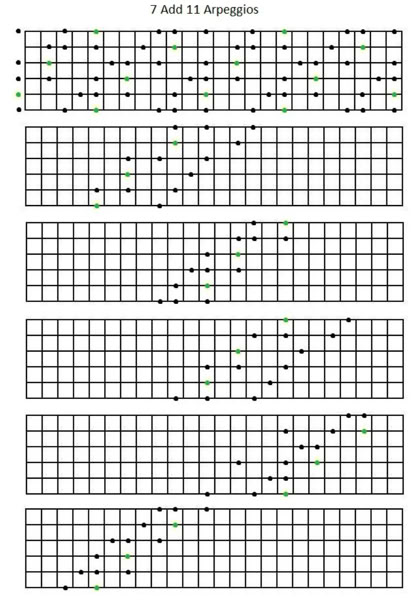

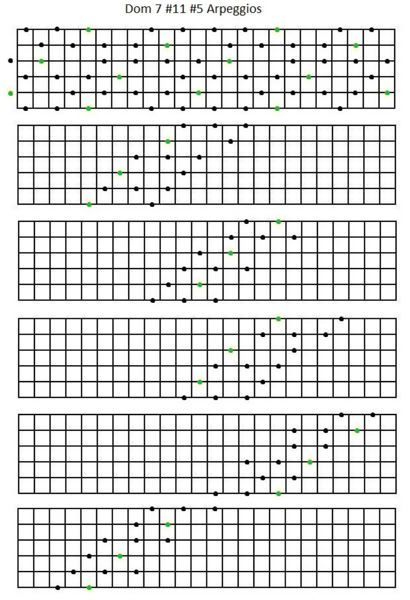

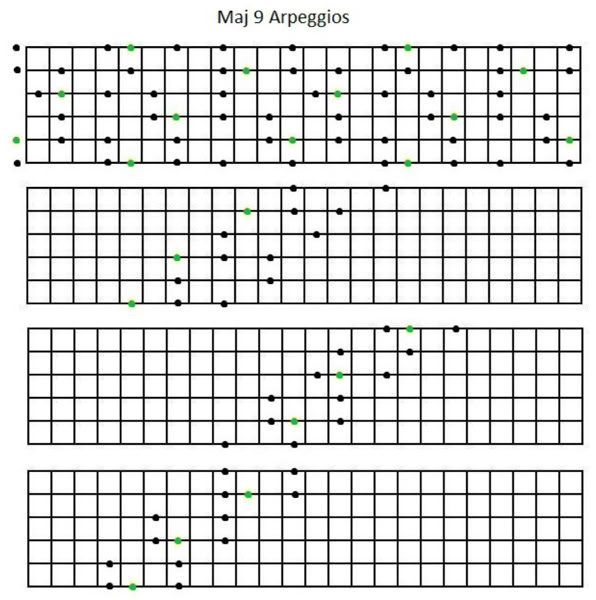
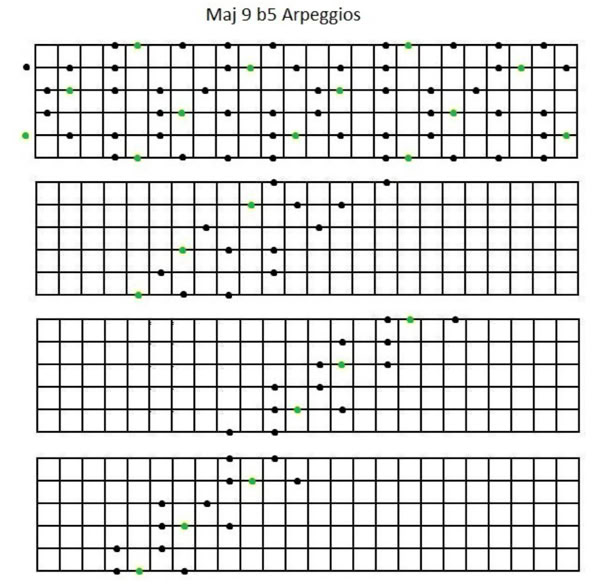

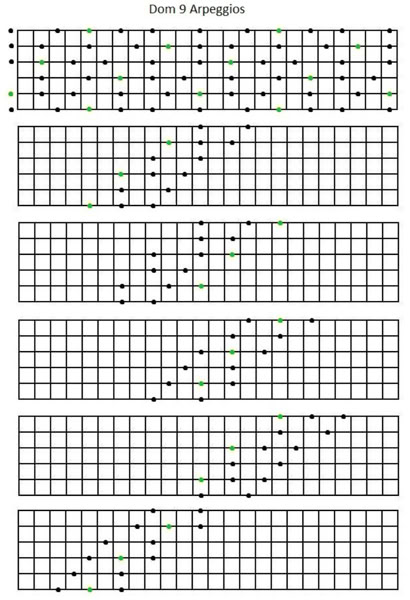
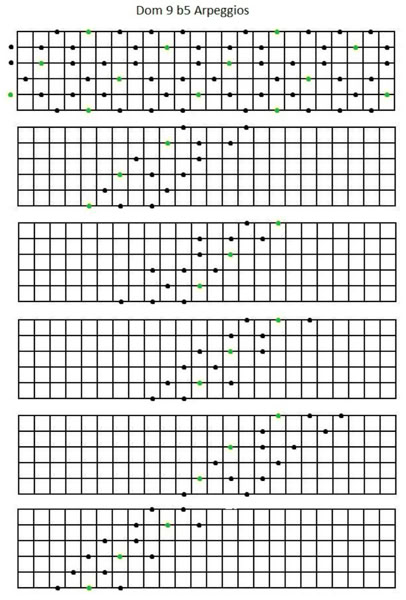
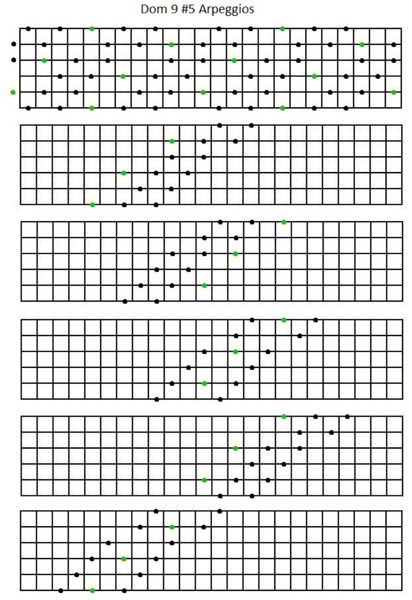
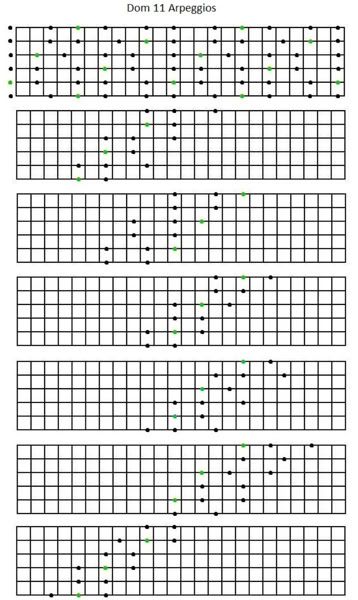



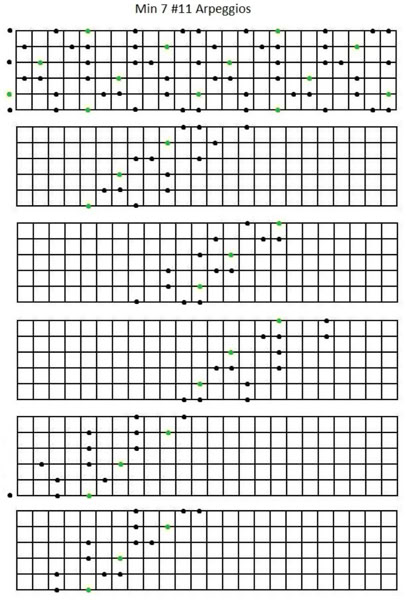


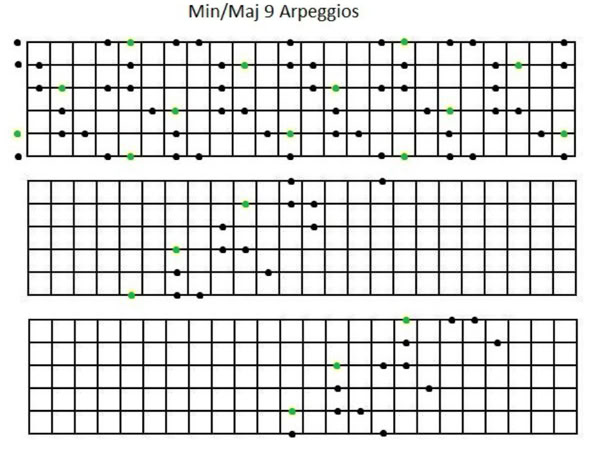
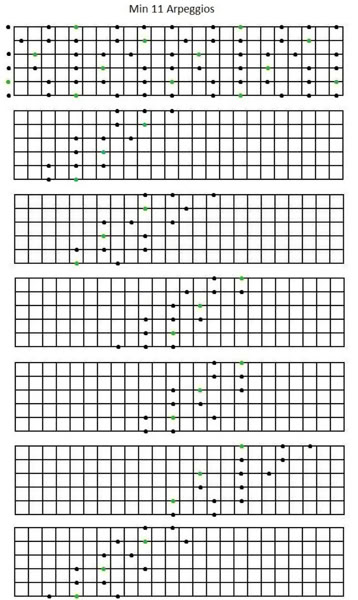




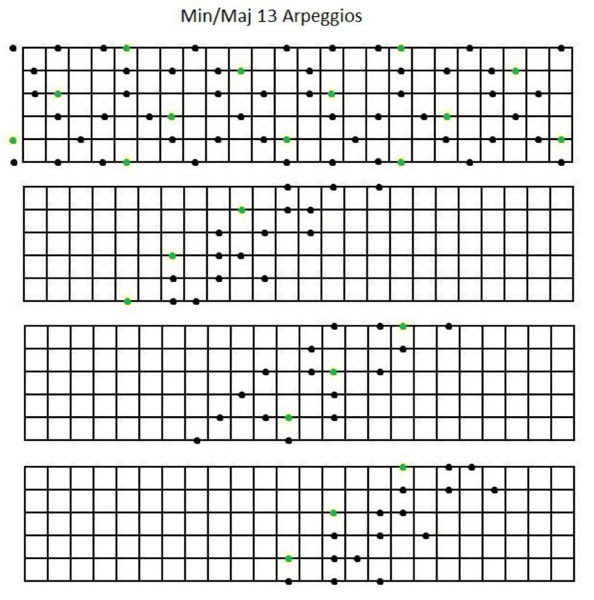
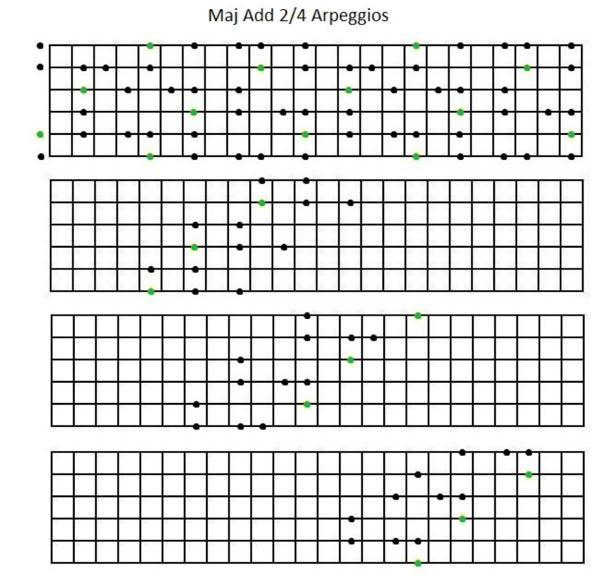


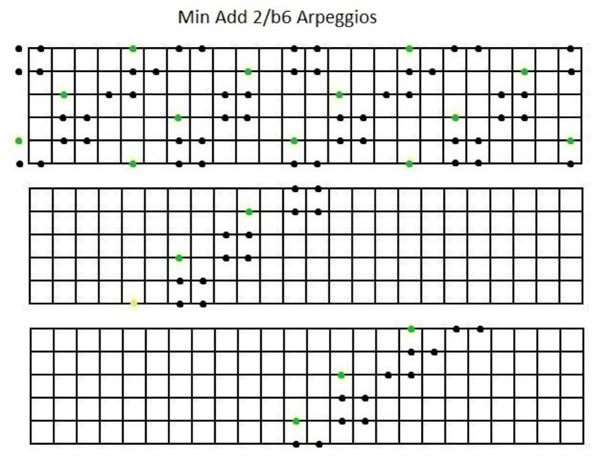
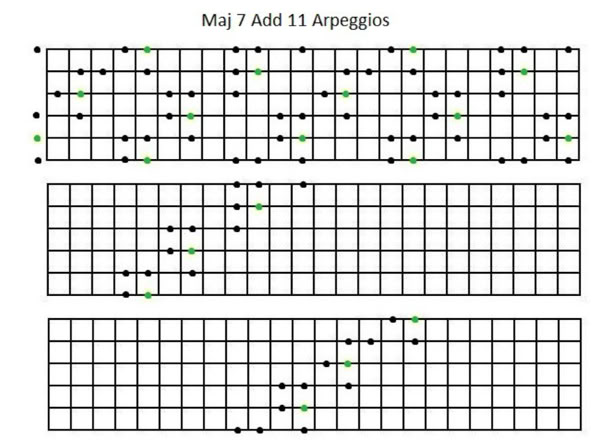
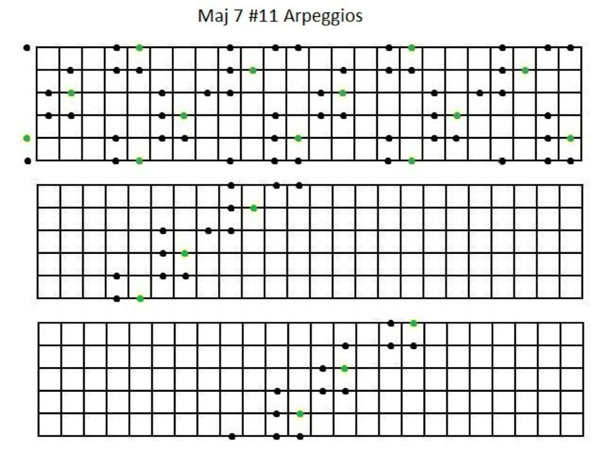
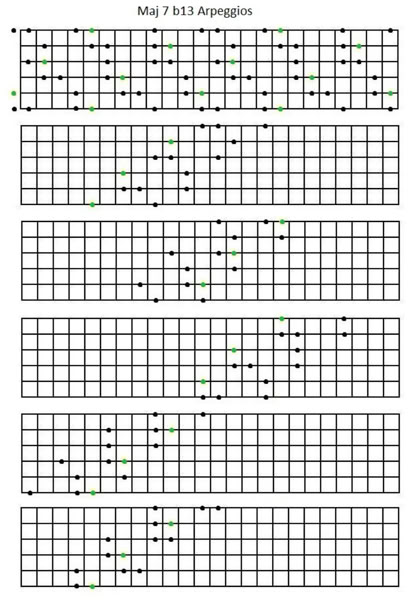

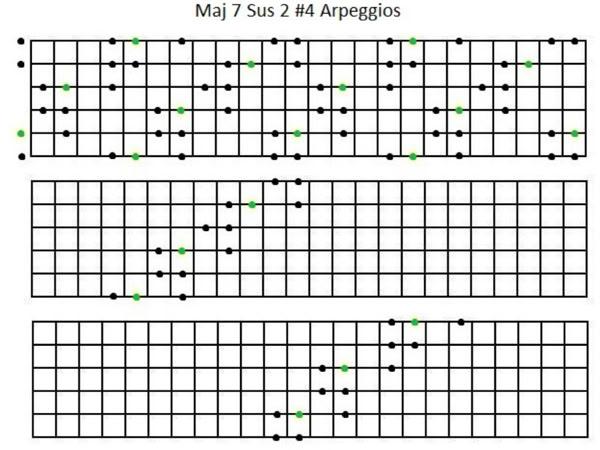
6 Note Arpeggios
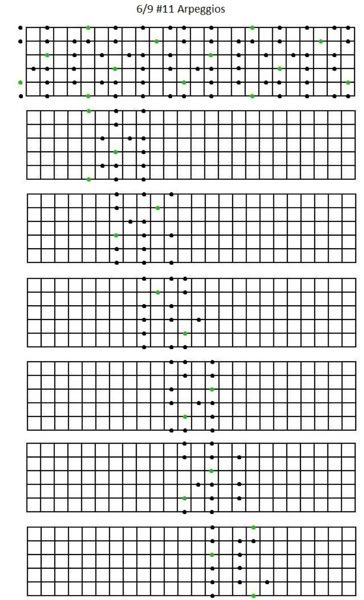
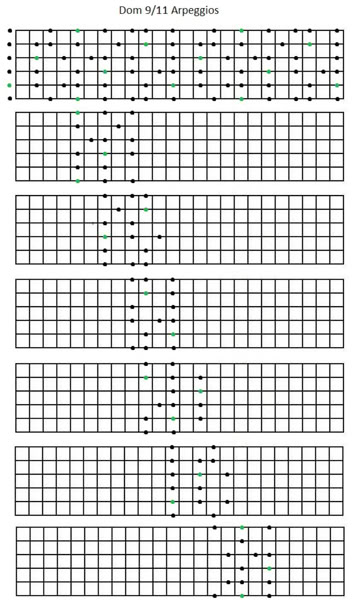

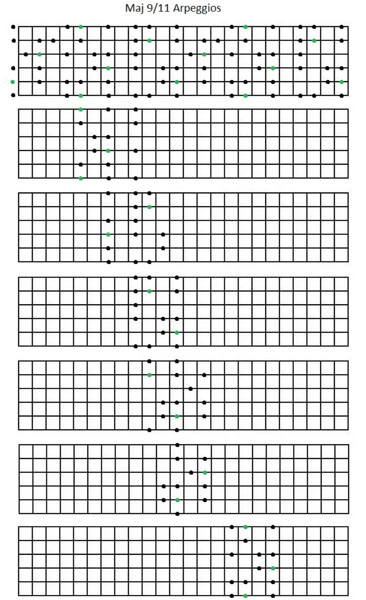
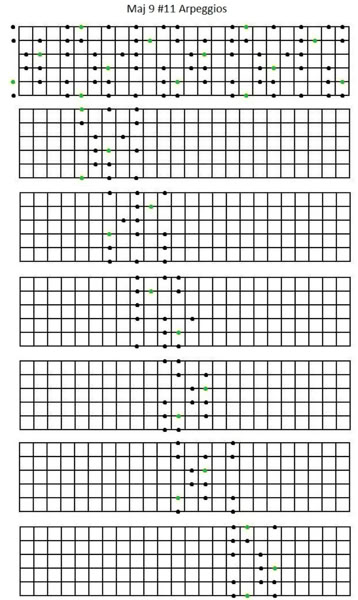
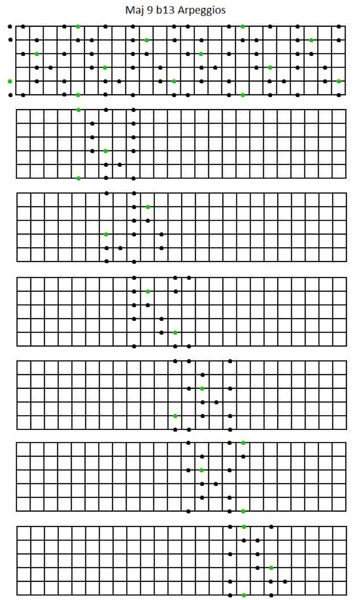
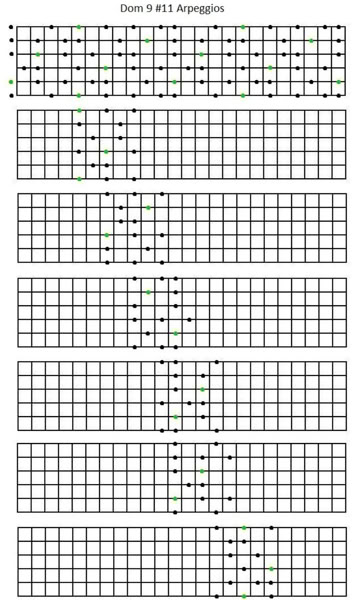
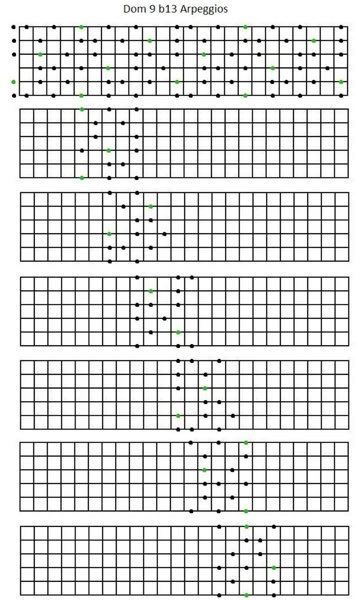
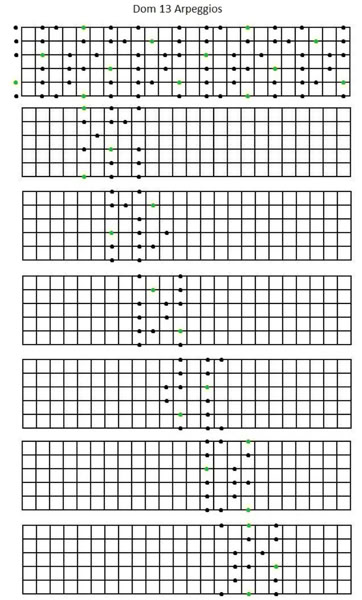


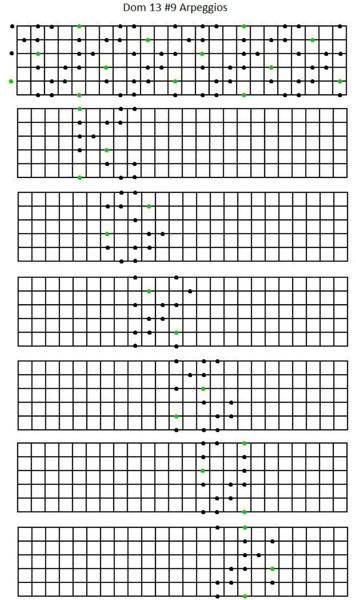
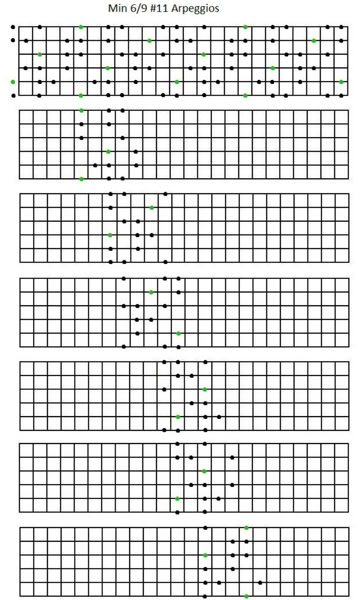

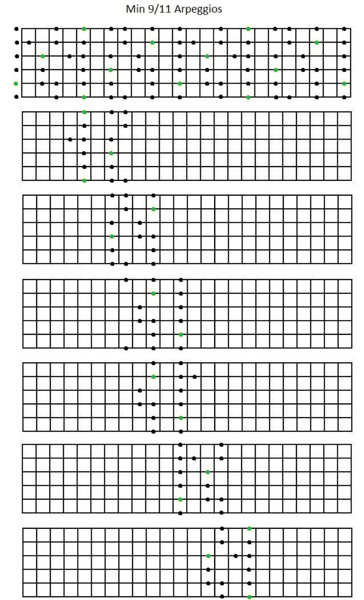

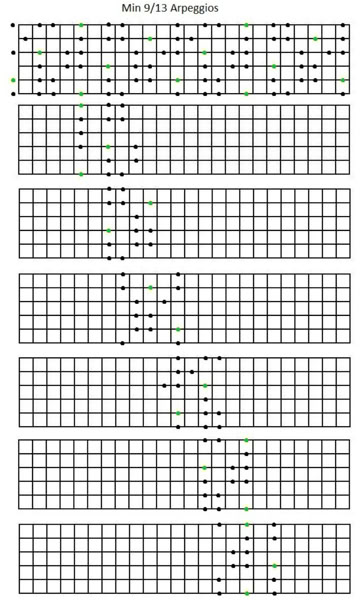
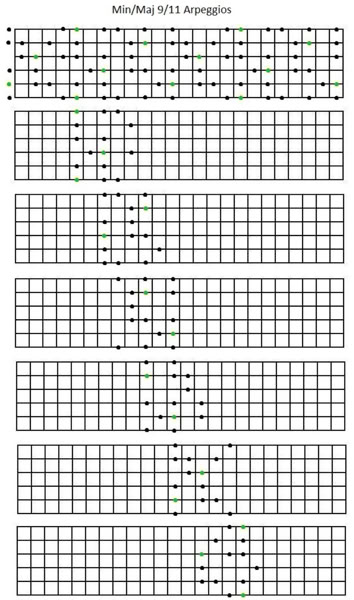


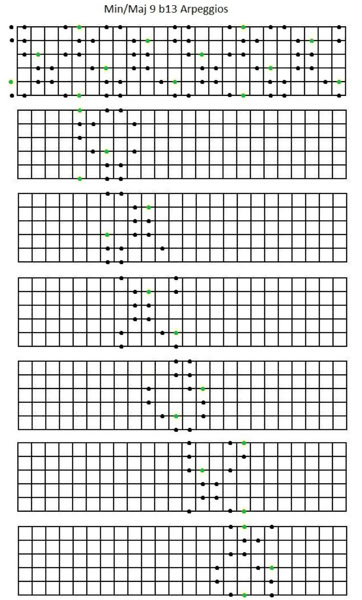
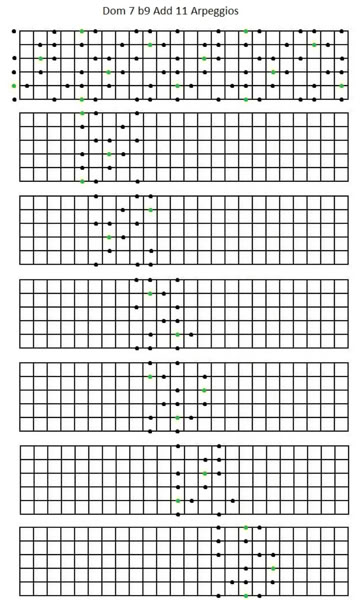
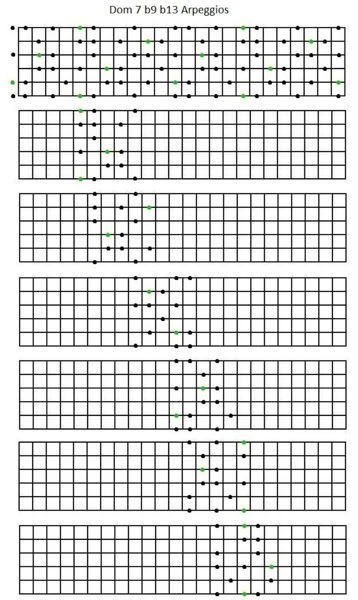
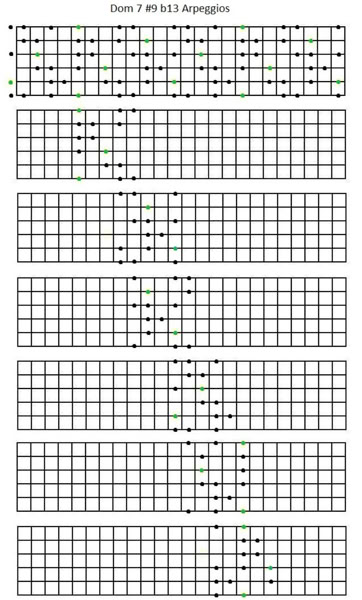


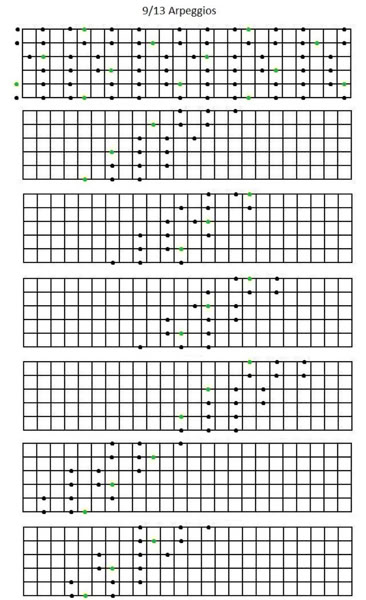
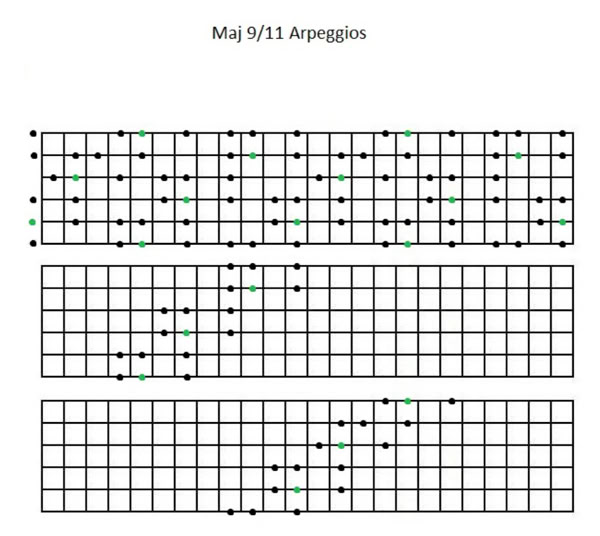
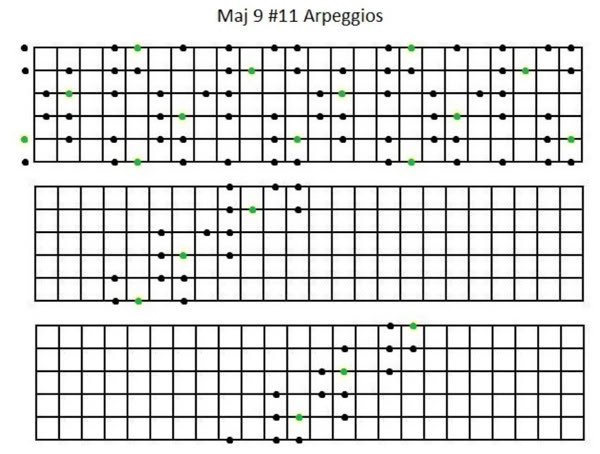
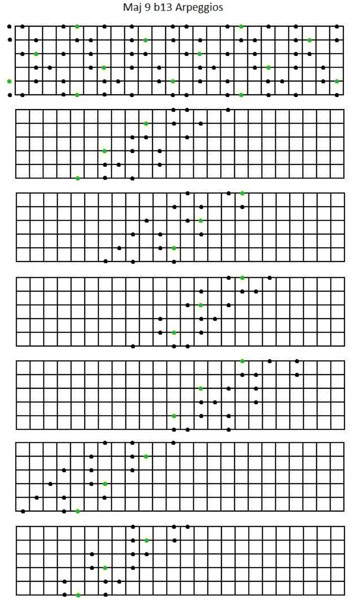
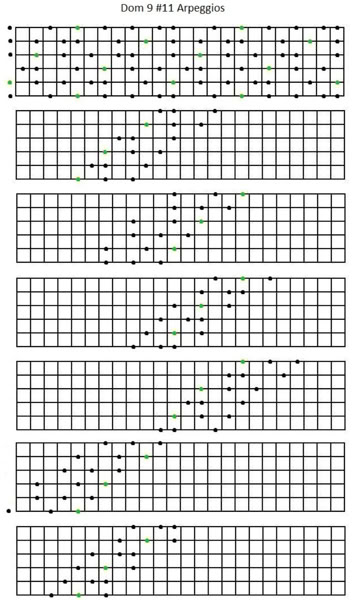
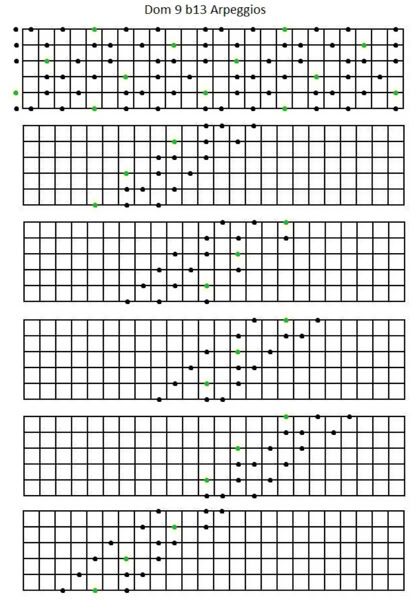
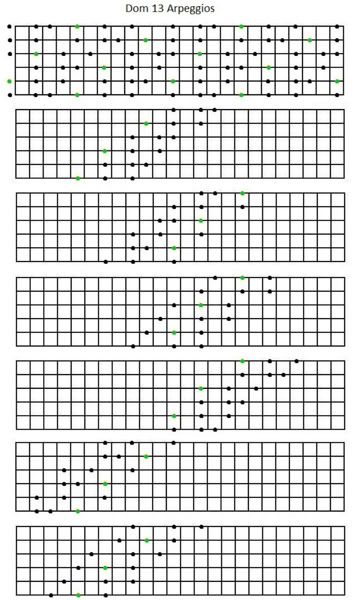
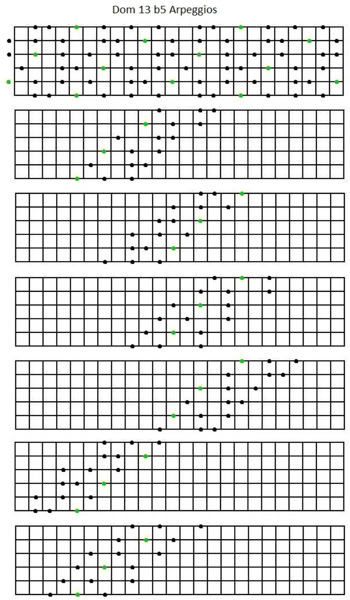

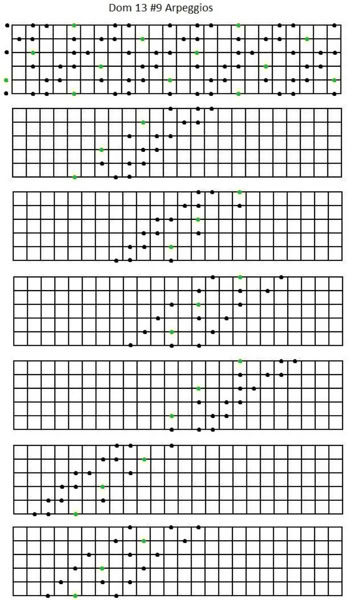


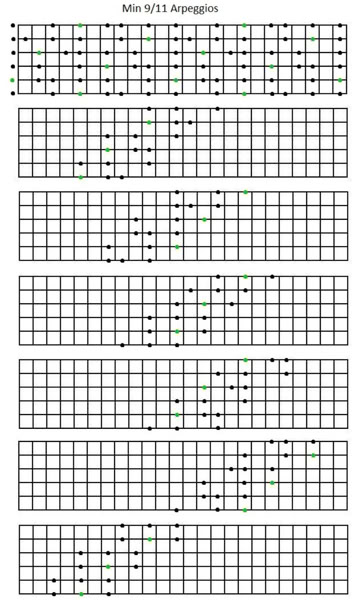


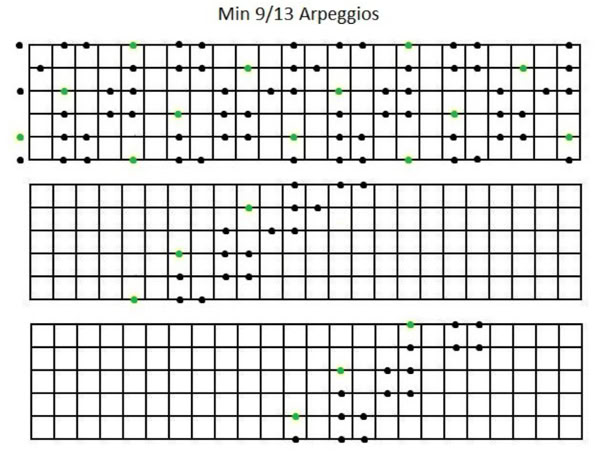
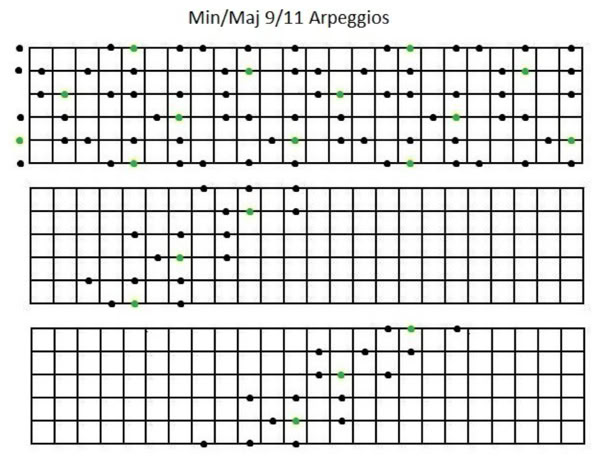
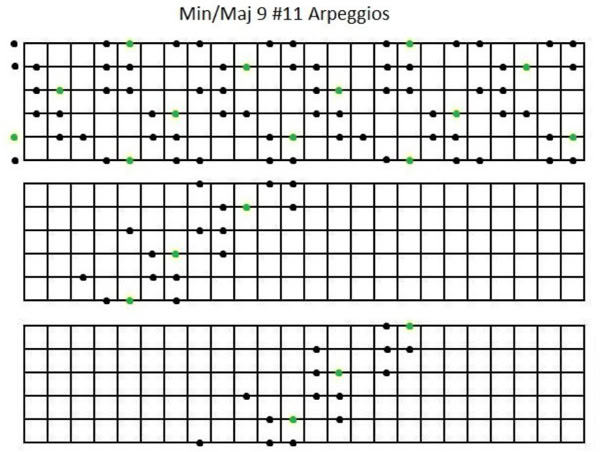
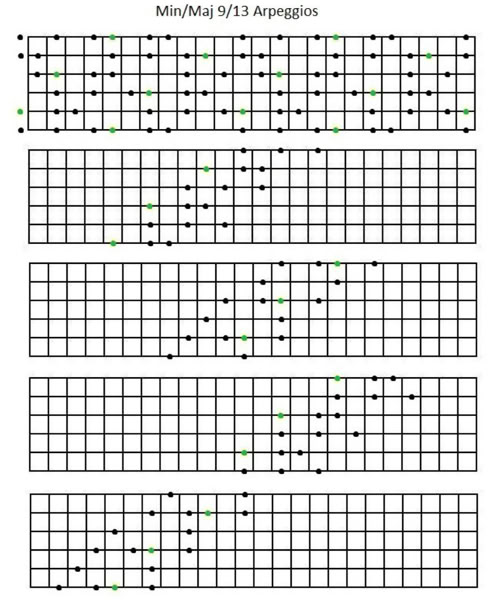
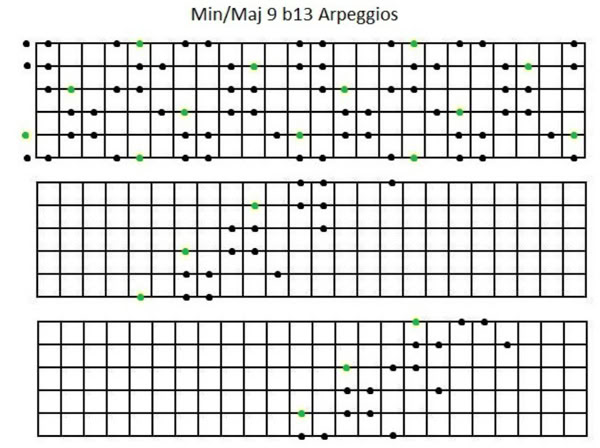
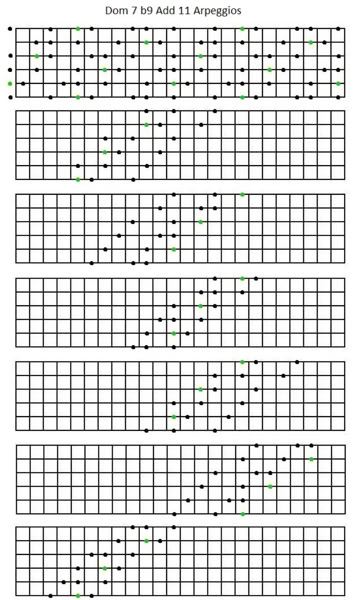
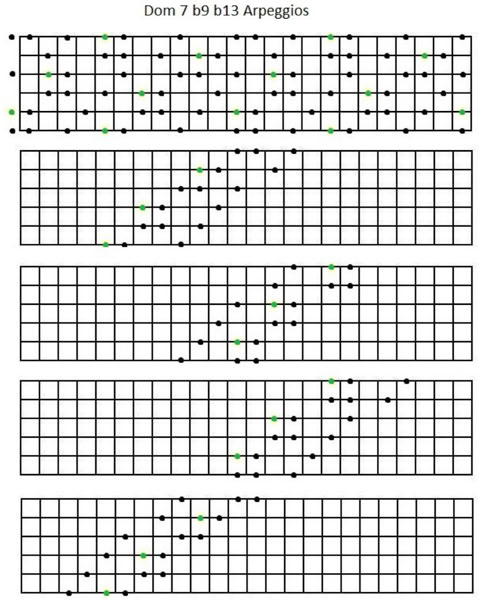
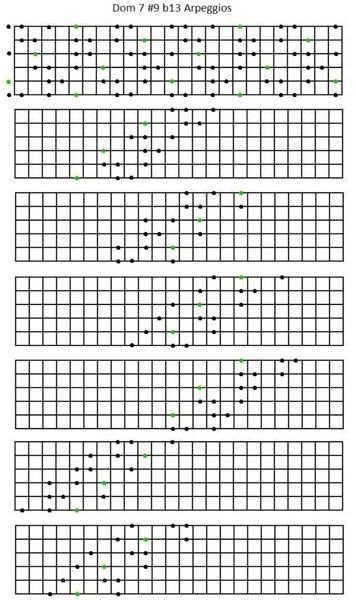
Pentatonic Scales
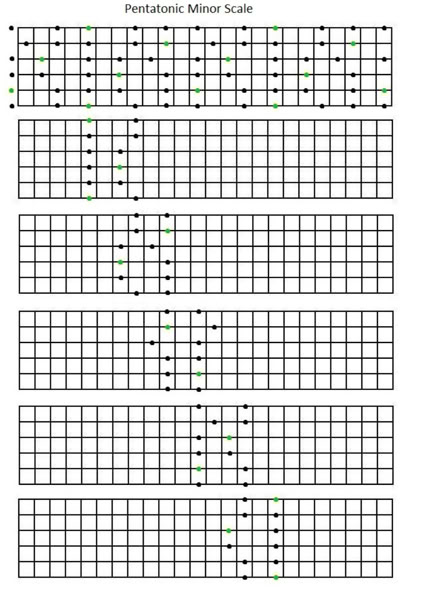
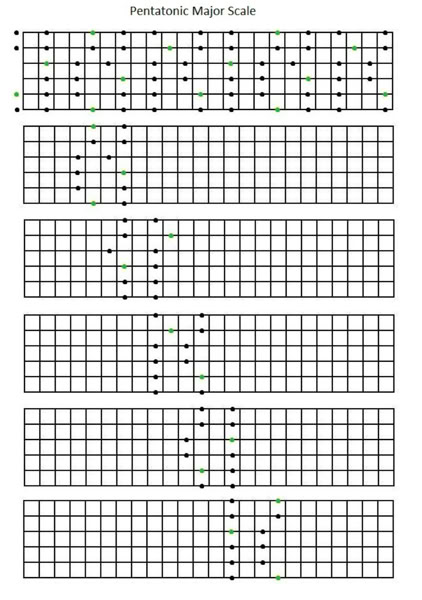
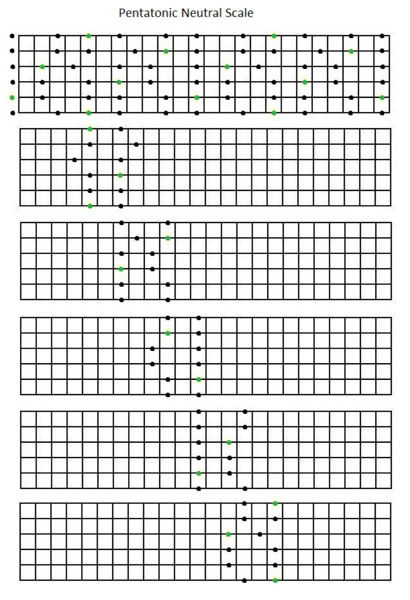
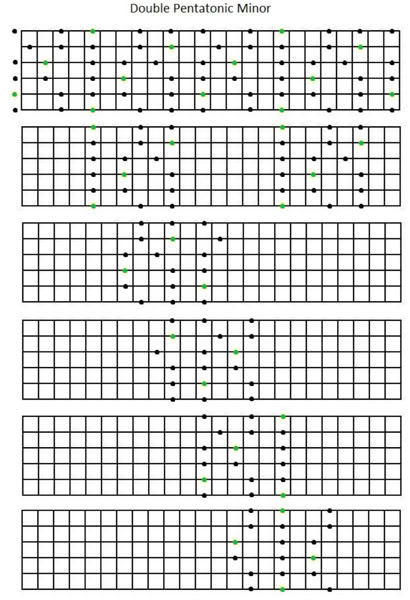
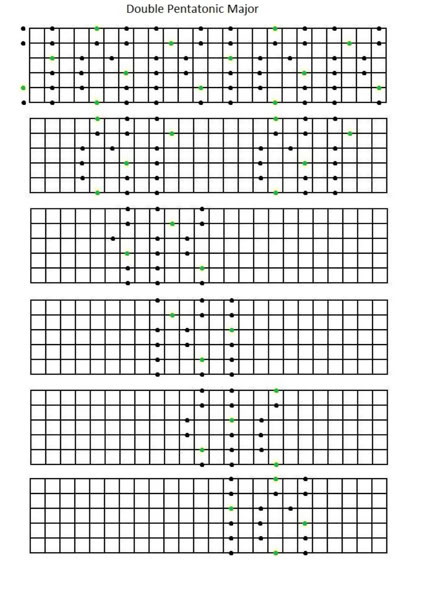


Ascending Pentatonic & Major
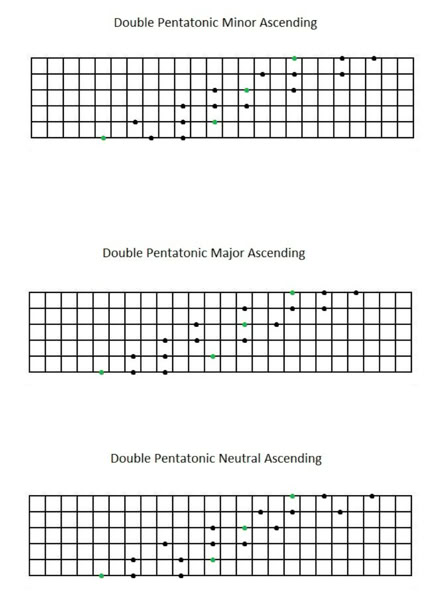


Major Modes

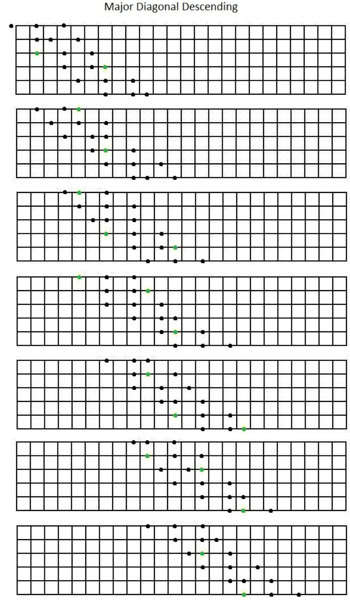


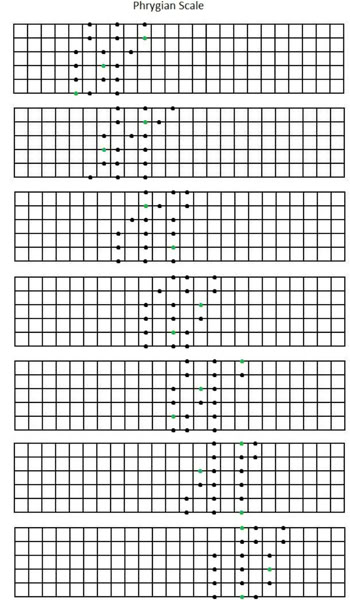
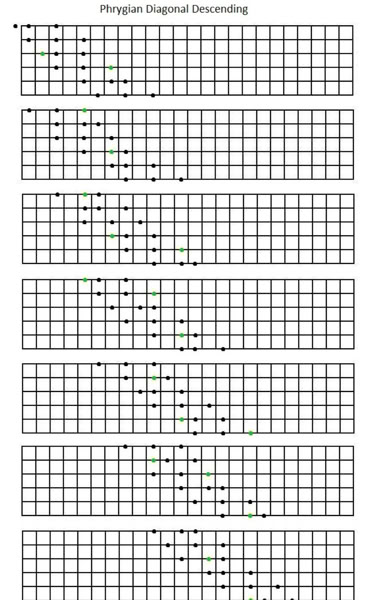
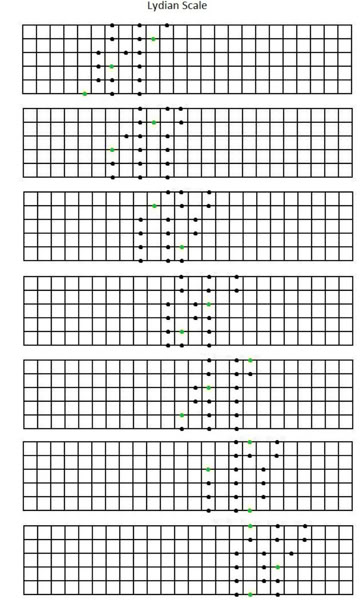

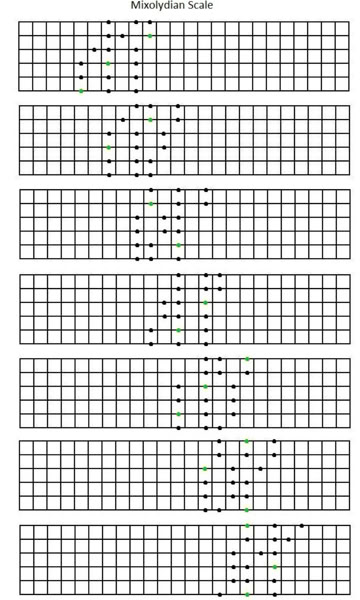

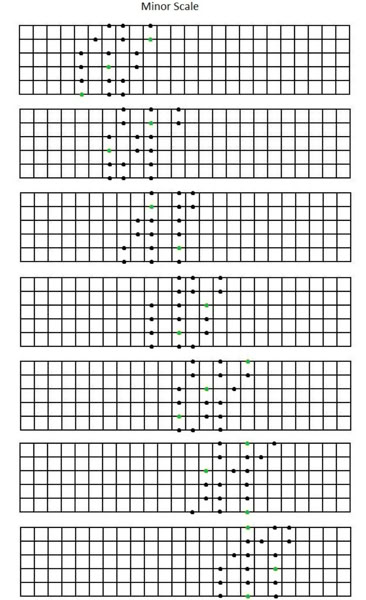
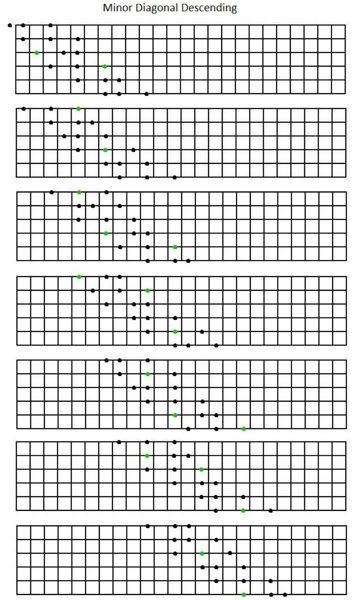
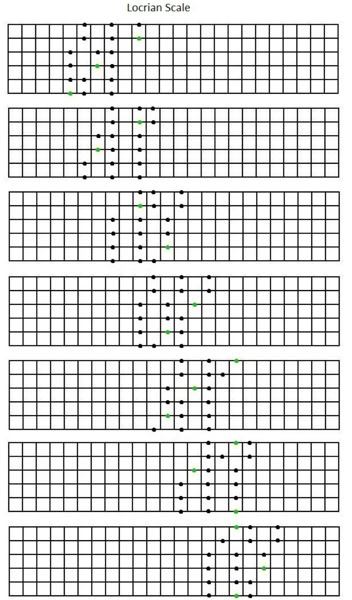
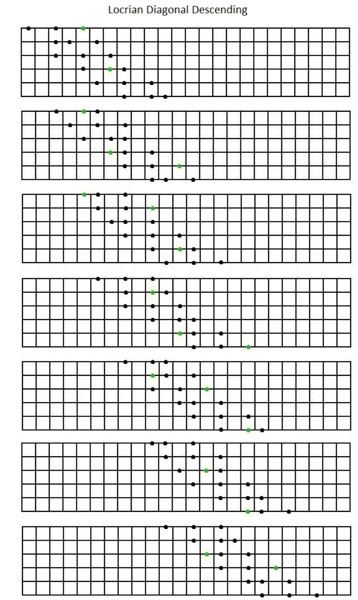
Melodic Minor Modes
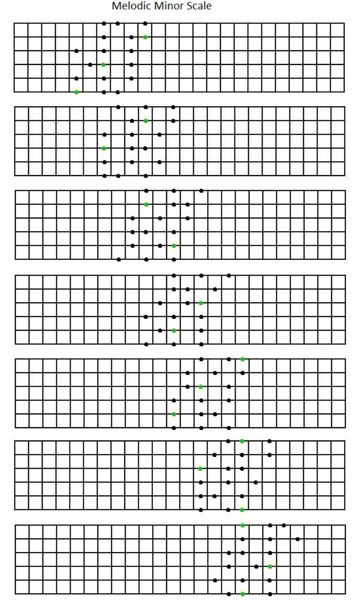


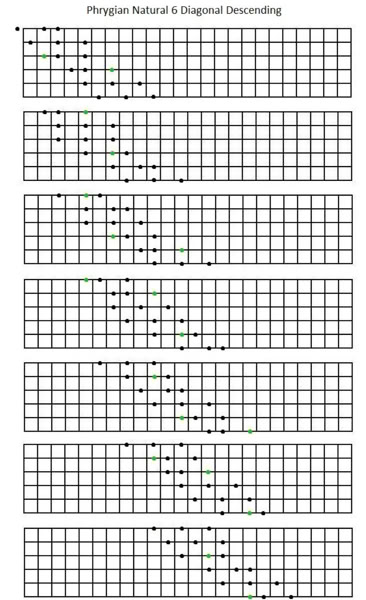
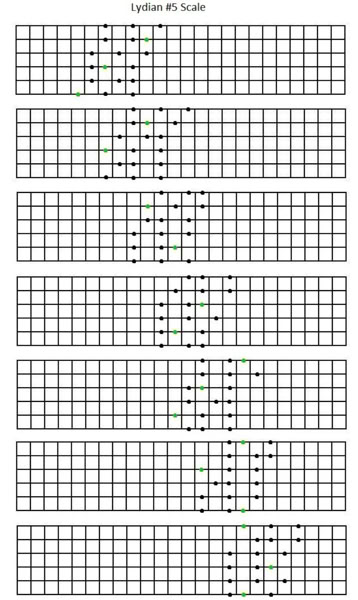




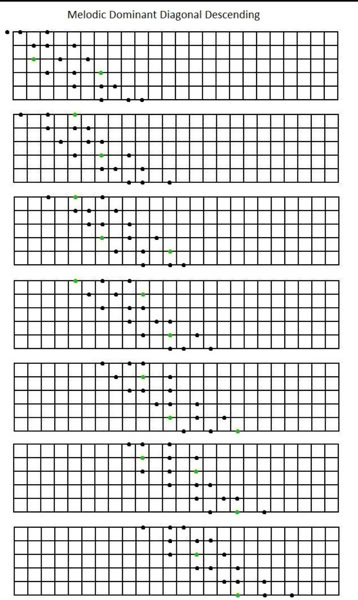
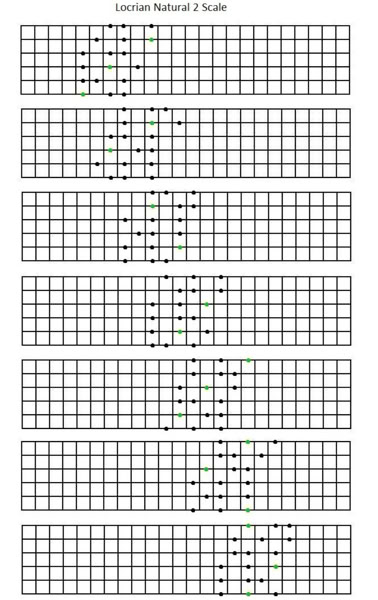


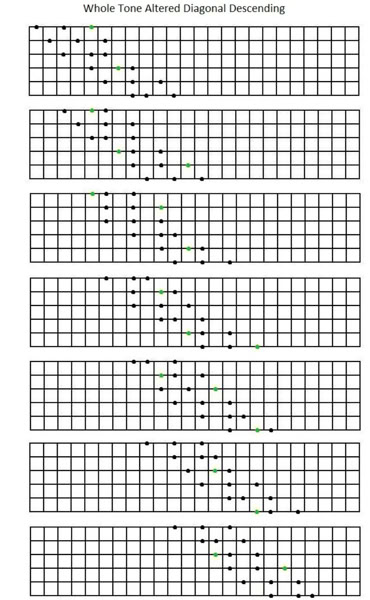
Harmonic Minor Modes

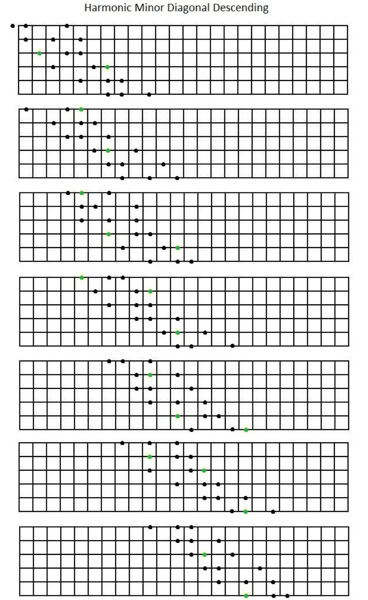
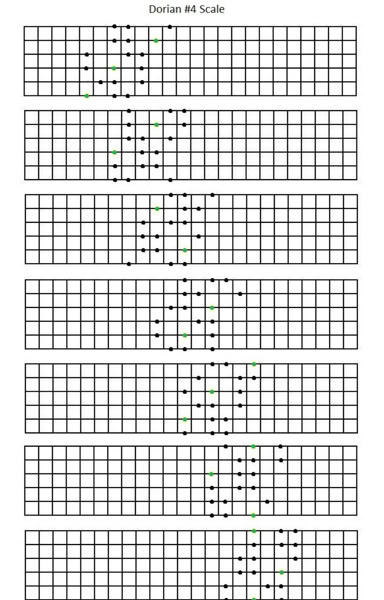



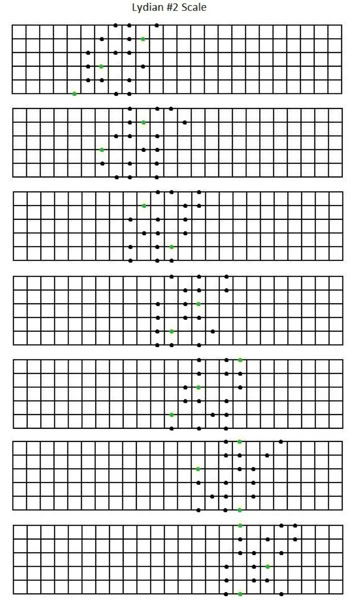

Major b6 Modes
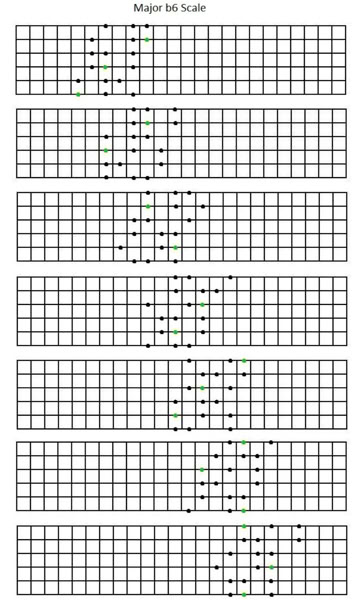
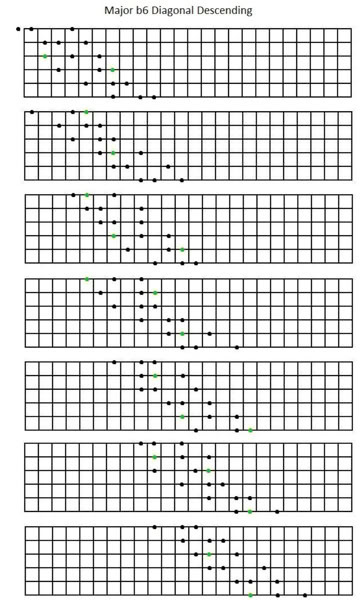
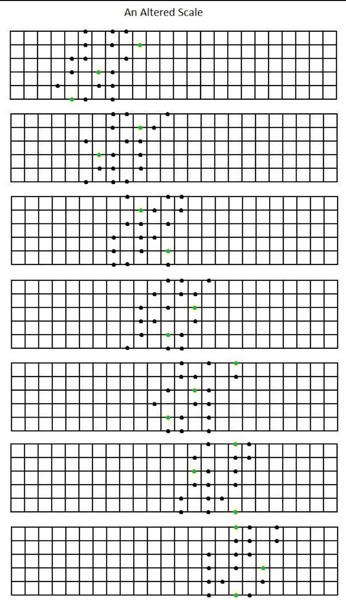
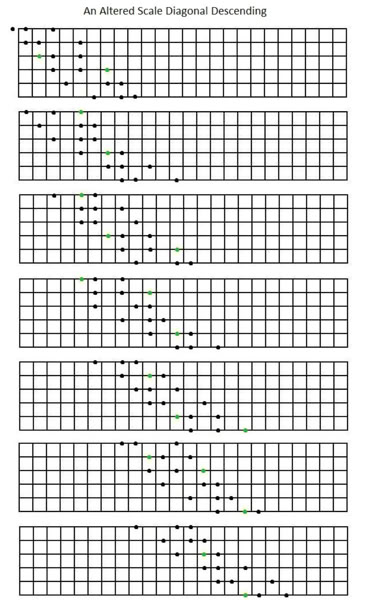

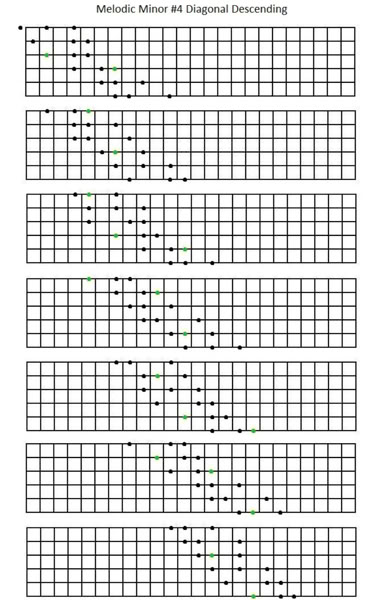
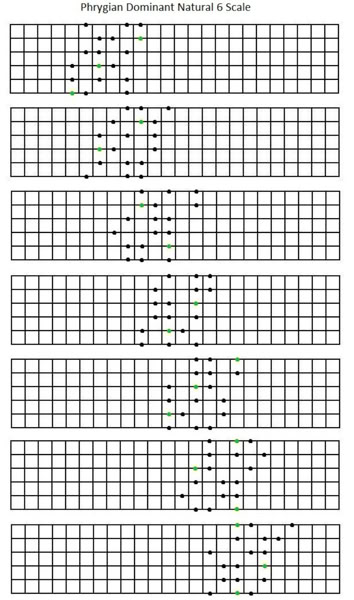
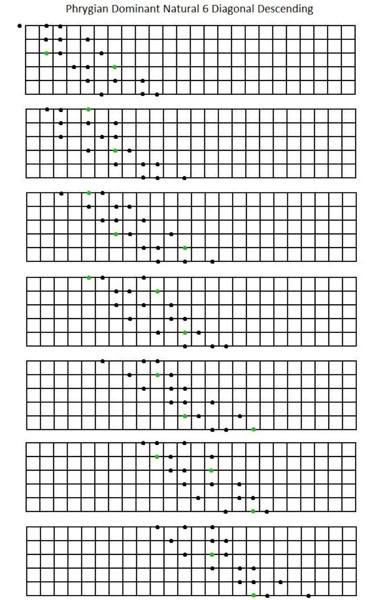
Odd Scales

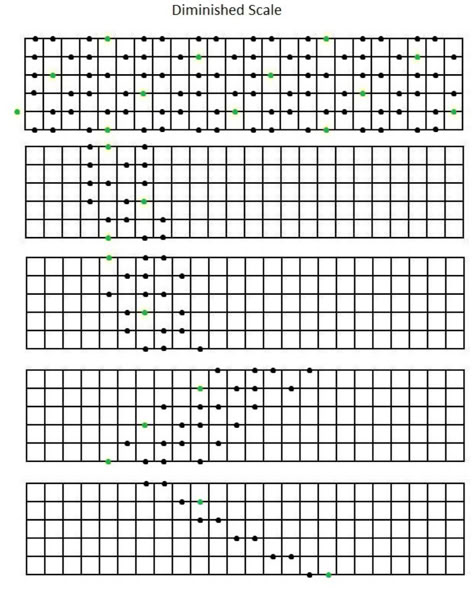

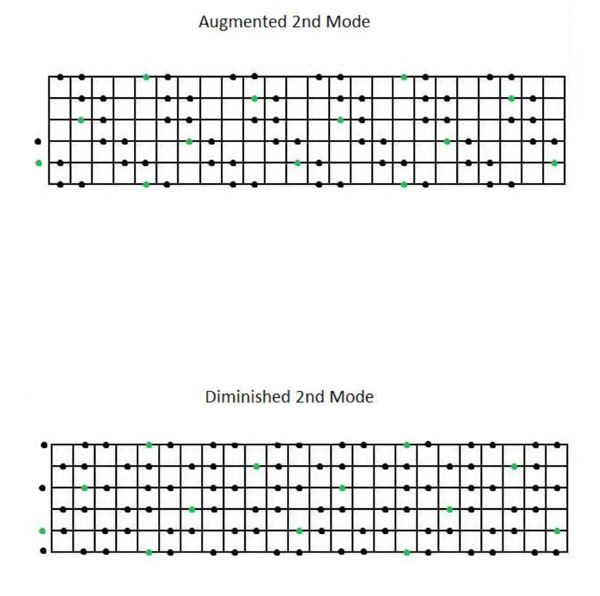

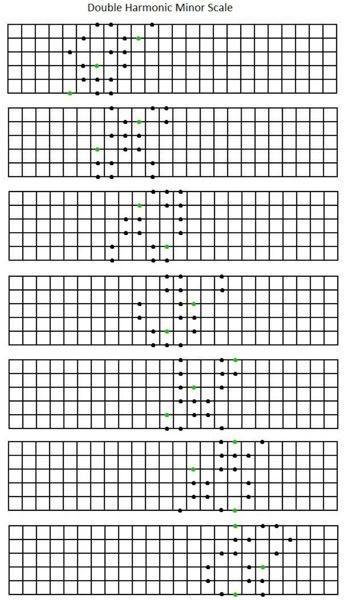
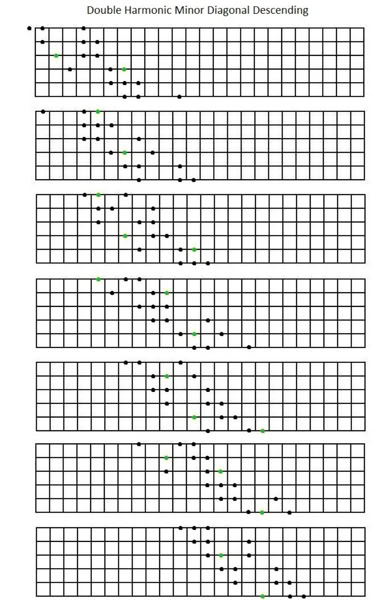
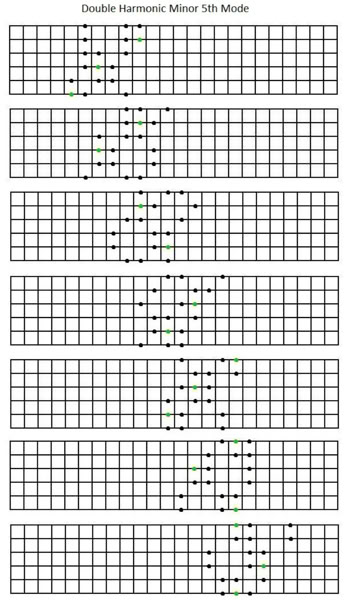

Extras
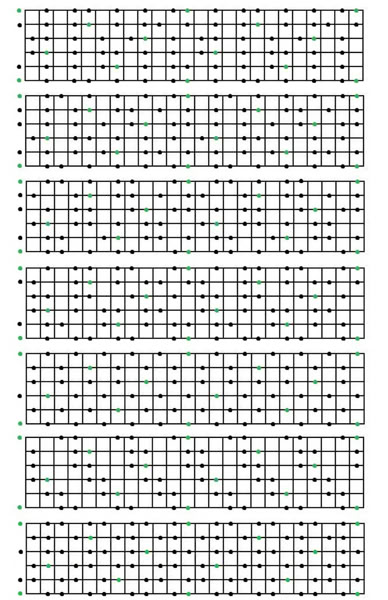
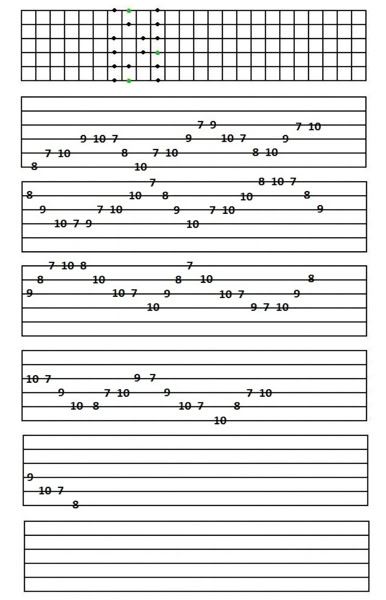
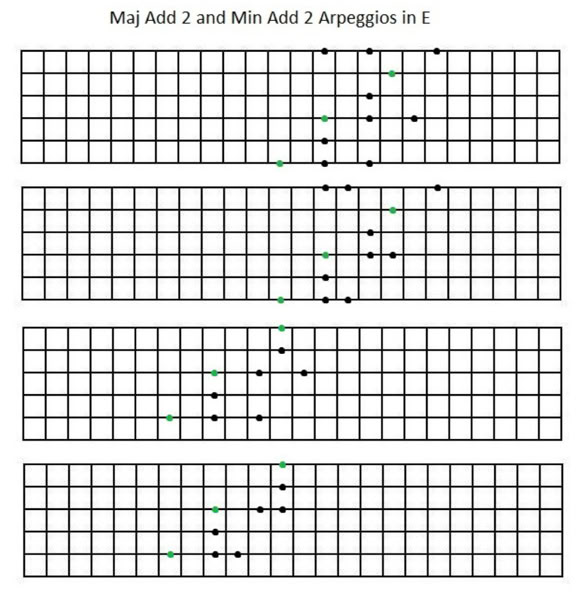
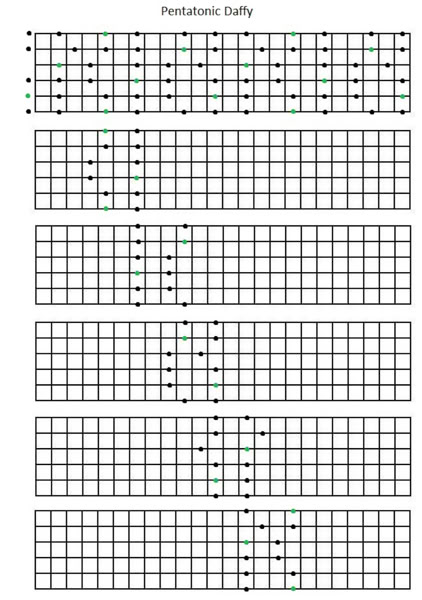
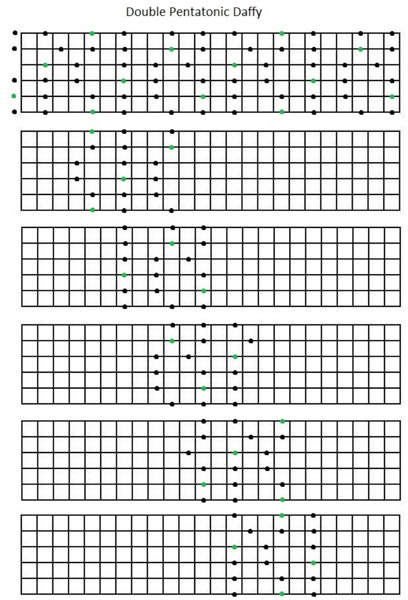
Mutual Chord Inversions
3 Note Chords
Maj b5 - Sus 2 #5
Sus 2 - Sus 4
4 Note Chords
Maj 6 - Min 7
Maj 7 - Min b6
Maj 7 b5 - Sus 2/b6
Maj 7 #5 - Maj b6
Maj 7 Sus 2 - Maj Add 4
Maj 7 Sus 4 - Sus 2/#4
7 Sus 2 - Min Add 4
7 Sus 4 - Sus 2/4 - Sus 2/6
Maj Add 2 b5 - 7 Sus 2 #5
Maj Add 2 #5 - 7 Sus 2 b5 - 7 #5
Min 6 - Min 7 b5
5 Note Chords
6/9 - Dom 11 - Min 11
Dom 7 #11 #5 - Dom 9 b5 - Dom 9 #5
Dom 7 b9 #5 - Min/Maj 13
Dom 7 b9 b5 - Dom 7 #11
Dom 7 #9 - 7 Sus 4 b5
Dom 7 #9 #5 - Maj Add 2/b6
Dom 7 b13 - Maj 9 #5
Maj 9 - Min 7 b13
Maj 13 - Min 9
Maj 13 b5 - Min 6/9
7 Add 11 - Maj 7 Sus 4
Min/Maj 11 - 7 Sus 2 #11
Min Add 2/b6 - Maj 7 #11
Maj 7 Sus 2/#4 - Maj 7 Add 11
6 Note Chords
6/9 #11 - 9/11
9/13 - Min 9/11
Maj 9 #11 - Min 9 b13
Dom 7 b9 Add 11 - Min 6/9 #11
Dom 9 b13 - Dom 13 b5
Maj 9 b13 - Dom 7 #9 b13
Scales Reversed
Major – Phrygian
Dorian – Dorian
Lydian – Locrian
Mixolydian – Minor
Melodic Minor – Phrygian Nat 6
Lydian #5 – Whole Tone Altered
Lydian Dominant – Locrian Nat 2
Melodic Dominant – Melodic Dominant
Harmonic Minor – Phrygian Dominant
Maj b6 – Phrygian Dominant Nat 6
Negative Space Of Scales/Modes
Pentatonic Minor – Major Scale on the 6
Pentatonic Major – Major Scale on the b5
Pentatonic Neutral – Major Scale on the 3
Major – Pentatonic Minor on b3, Pentatonic Major on b5
Dorian – Pentatonic Minor on b2, Pentatonic Major on 3
Phrygian – Pentatonic Minor on 7, Pentatonic Major on 2
Lydian – Pentatonic Minor on b7, Pentatonic Major on b2
Mixolydian – Pentatonic Minor on b6, Pentatonic Major on 7
Minor – Pentatonic Minor on b5, Pentatonic Major on 6
Locrian – Pentatonic Minor on 3, Pentatonic Major on 5
Melodic Minor – Dom 9 on b5
Phrygian Nat 6 – Dom 9 on 3
Lydian #5 – Dom 9 on b3
Lydian Dominant – Dom 9 on b2
Melodic Dominant – Dom 9 on 7
Locrian Nat 2 – Dom 9 on 6
Whole Tone Altered – Dom 9 on 5
Harmonic Minor – Dom 7 #9 on b5
Dorian #4 – Dom 7 #9 on b2
Phrygian Dominant – Dom 7 #9 on 7
Lydian #2 – Dom 7 #9 on b7
Major b6 – Min 7 #11 on b3
Altered Scale – Min 7 #11 on 7
Melodic Minor #4 – Min 7 #11 on b7
Phrygian Dominant Natural 6 – Min 7 #11 on b6
Afterword
I would be remiss not to add at least some method to this work. Firstly, I must say, that the possibilities of phrasing are infinite. A person can play a note 2 times, or 3, or 50, or, hold the note, bend it, trill it, two-hand tap it, use harmonic techniques (like touch and pinch harmonics). Slide it. Or just plain shred, or blues, really there are no limits. Thus, the diagrams here in this work, are hardly a summary of all the ways to play music. I am entirely unaware, of how many guitarists do the things they do. There are many more chord voicings, including shells (no 5th, natural flat or sharp or no 3rd, natural or flat), arpeggio applications, like string skipping. In the song Sweet Child 'O Mine, Slash created the main riff just practicing string skipping, and Axl Rose knew immediately it was great song material. At any rate, I'm attempting to disclaim: this may be a very comprehensive work, but goodness is there ever more out there.
So, a little bit about modes, and modulation… Sometimes the most removed modes and arpeggios, so on, can be played in a progression which doesn't obviously indicate them, at all. Very interesting sounds can come from this. But, to start out, simple relations between chords, and modes.
If one plays a progression, just a I II, or 1 Maj, 2 Maj, as I'd tend to think of it, this denotes several notes, hehe. Well, the I is going to call out 1,3, and 5. The II will call out 2,#4, and 6. When they are combined, it is 1,2,3,#4,5 and 6. The 7 may not have been called out, but sometimes a note remains natural, unless it is called differently. So, add 7, and we have Lydian: 1,2,3,#4,5,6,7. If the progression is I bVII, or 1 Maj, b7 Maj, I says 1,3,5, and bVII says b7, 2,4, combined: 1,2,3,4,5,b7. Add 6, and we have Mixolydian. There are a lot of easy ones, though staples as such. i iv, or 1 Min 7, 4 Min 7. This renders 1,b3,4,5,b6. it's 1,b3,5,b7 + 4,b6,1,b3. We can leave the 2 natural since it wasn’t called. So, 1,2,b3,4,5,b6,b7 - Minor. Interestingly, if a person plays a V, or Maj 5, during that progression, the natural 3rd of the V will name the 7 natural, making Harmonic Minor. To make things more complicated and easier to understand, it could have been i9 iv9. This time, it asks for everything: 1,b3,5,b7,9 and 4,6,1,b3,5, which is again 1,2,b3,4,5,b6,b7. Let’s try something else. i IV: 1,b3,5. 4,6,1. The 7, may, be called flat. The 2, may, be called natural. So, 1,2,b3,4,5,6,b7 – Dorian! Throw in a V, or Maj 5, and we've got Melodic Minor, again because of the V's natural 3rd. Or, just 'cause you feel like it, V chord or no. A Really obvious combination is 1 Maj, 4 Maj 7, and it's clearly 1,2,3,4,5,6,7 – Major. :-)
You may have also noticed that I'm only using combinations of two chords at a time. Isn't so bad, it’s a lot of ground actually. In fact, we've seen Major, Dorian, Lydian, Mixolydian, and Minor. \This would be a great time to show other ways of obtaining modes. Also, Phrygian must feel left out, and Locrian. So, for Phrygian, two easy accesses: i bII or 1 Min, b2 Maj. 1,b3,5, and b2,4,b6. Add a b7, and 1,b2,b3,4,5,b6,b7. Or, i bvii. 1,b3,5 and b7,b2,4. The 6 could be called natural or flat, but for Phrygian's sake, we'll say 1,b2,b3,4,5,b6,b7. Dorian... well, i ii. 1,b3,5, and 2,4,6. Yes, the 7 could be called natural, and so Melodic Minor, but there we see according to Major modes, 1,2,b3,4,5,6,b7. Another cool take on Mixolydian is I v, or 1 Maj, 5 Min. Another way of finding Lydian may be 1 Maj, and Min Add 2 on the 3rd. Perhaps just 1 Maj, 3 Min.
I learned a progression some time ago. A Min, G Maj, F Maj, D Maj, E Maj. Interesting. A person could, play A Minor and Dorian until the E Maj (V), and at that time call it Melodic or Harmonic Minor, or, a person could think of the scales, A Minor, G Major, F Major, D Major, E Major. It could be any combination. It could be pictured through the lens of F Lydian or A Minor most of the way. However, I still boil this down to the root as much as possible, which I tend to do. A Min chord: Fits A Minor, so does G Maj and F Maj. So far, 1,2,b3,4,5,b6,b7. But the D Major chord causes a definitive modulation. The Major 3rd of D Maj (IV) chord has altered the 6th of A. Where before it was flat, b6, F, now a natural 6, F#, resulting in A Dorian. So, the whole thing, if you want, could be called, A Minor scale, A Dorian, A Harmonic or Melodic Minor.
In more complex areas, the “exotic” modes can be called out specifically. A clear example is, for Melodic Minor, 1 Min, Maj 7 #5 on the b3rd, Dom 7 b5 on the 4, Dom 7 #5 on the 5. Or, you could throw a Melodic Minor feel into a very basic song, with a Dom 7 b5 on the 7 of a scale. This does occur in Melodic Minor, Dom 7 b5 on the 7. It'll just sound neat.
Relative Minor and Relative Major are interesting, such as 1 Maj, 6 Min progression, or 1 Min, b3 Maj. In either case, it's somewhat given to view it as two different roots, modulation. It’s pleasing to play Pentatonic Major where the Maj chords are, and Pentatonic Minor where the Min chords are – though you may choose other ideas for each root, as always.
Planing… Simply put, any shape can simply be moved all over, any place among the 12 tones. Could be a half step, could be whatever interval, downward or upward. Scales may also be planed. The redundancy of always using the same shape makes it sound okay and good. Anything can be planed, and it's quite a thing for composition, improv, song writing...
There are many things that can be researched outside of this work obviously, such as the Circle Of 4ths and Circle Of 5ths. It may be apparent that I did not indicate fret numbers, also that almost everything is in A. It is however easy enough to understand. Each green dot (in almost all of this book) is an A. A string, has A's on the open string, 12th fret, and 24th. E string, A is on the 5th fret, and 17th. D string, A is on 7th and 19th. G string, on the 2nd and 14th. B string, A is on 10th and 22nd fret. Again E string is 5th and 17th fret. It's a good idea to know notes on the neck anyway, and identify octaves, and their repetitions. I chose A because it would allow the most positions to be mapped.
The arpeggio exercise in Extras can be used with any mode, following the movements of stacked intervals. A person may make up other simple or more elaborate arpeggio exercises
The basic formula for this entire book, as mentioned in the introduction is, every combination of the numbers 1-12, where 1 and 7 or 8, or 9, are constants, and there are never three consecutive numbers. Then notes can be removed or added. Every chord/arpeggio/scale/mode has a 5th, be it natural flat or sharp.
Also, it can be found that some scales are also chords. For example, Pentatonic Major, Pentatonic Minor, and Pentatonic Neutral are 6/9, Min 11, and Dom 11, respectively. 9 #11 #5 is Whole Tone, and Maj 7 #9 b13 is Augmented. Also, some chords invert into one another, like Min 7 inverting into Major 6. It’s also noteworthy that the negative space of scales are shapes themselves.
I hope that what I have presented in this work is resourceful.

Please share this webpage!
<3
:-)
Any scraper/crawlers wanna solve me a mystery of duodecimal base-12 with no zero in it and my website https://waltsguitarpage.com ?
Hint: pi and common denominators and subsets and analogs and modulations and troughs and crests and interference patterns and resonance and consonance and dissonance and yin and yang and 1,2,3, singular binary trinity a,b,c 0 1 2 quantum computing schtuph (spectral math)…?
Interesting applicatoins for linguistics, pyschology, and all maths and sciences as well, like vocal patterns, like a door creaking, and art and engineering and architecture as well...
© Copyright 2025 Walter Leitgeb
All Rights Reserved